

Decoding China Visa Categories: Find Out Which One Suits Your Purpose
Welcome to the ultimate guide on China visa categories! Are you planning a trip to the captivating land of ancient history, vibrant culture, and stunning landscapes? Then brace yourself for an adventure like no other.
But before you embark on this journey, it’s crucial to understand the various types of visas available and which one suits your purpose. Whether you’re a tourist eager to explore iconic landmarks or an entrepreneur looking to tap into China’s booming market, we’ve got you covered. Join us as we decode each visa category, demystify their requirements, and help you navigate through the complexities of obtaining your ticket into this incredible nation.
So let’s dive in and uncover the perfect visa that will open doors to unforgettable experiences in China!
Introduction to China Visa
China is a popular destination for tourists, students, and business professionals alike. With its rich history, vibrant culture, and booming economy, it’s no wonder that people from all over the world are eager to visit this fascinating country. However, before packing your bags and booking your flight, you need to make sure you have the proper documentation in place – a valid China visa.
A China visa is an official document issued by the Chinese government that allows foreigners to enter, exit or stay in the country for a specific period of time. It serves as proof that you have been granted permission to enter China by its authorities. Without a valid visa, travelers will not be allowed entry into China.
Types of China Visas
There are several types of visas available for entering China, each with its own unique requirements and purposes.
The most common categories include tourist (L Visa), business (M Visa), student (X Visa), and work (Z Visa) visas.
It is crucial to choose the right type of visa according to your purpose of travel. Applying for the wrong type may result in your application being rejected, leading to delays or even cancellation of your trip.
Make sure to carefully review all the requirements and regulations before applying for any visa. With proper planning and research, obtaining a visa for China should be a smooth and hassle-free process.
Tourist Visa (L Visa)

The L Visa, also known as the Tourist Visa, is one of the most commonly applied for categories of China visas. This visa is intended for individuals who wish to visit China for tourism purposes such as sightseeing, visiting friends and family, or engaging in other non-business related activities. The L Visa is typically issued for a period of 30-90 days and allows single-entry or multiple entries during its validity.
To apply for an L Visa, there are certain requirements that must be met. First and foremost, applicants must have a valid passport with at least six months remaining before expiration and at least one blank page for the visa stamp. It is also necessary to provide a completed visa application form with recent passport-sized photos attached. Additionally, applicants must provide proof of their travel arrangements such as flight tickets and hotel reservations.
In some cases, applicants may be required to submit an invitation letter from their host in China. This letter should include information about the applicant’s purpose of visit, duration of stay, accommodation arrangements, and details about the inviter (name, address, contact information). If staying with a friend or relative in China, it may be helpful to provide documents showing their relationship to the applicant (proof of kinship).
One important factor to keep in mind when applying for an L Visa is demonstrating strong ties outside of China. As this visa category is primarily intended for temporary visits only, immigration officers want assurance that the applicant has reasons to return home after their trip instead of seeking employment or overstaying in China illegally.
It is essential to note that while on an L Visa, visitors are not allowed to engage in any work-related activities within China unless they have obtained special permission beforehand. Violating this rule can lead to legal consequences and even deportation.
Once all required documents have been submitted and reviewed by Chinese authorities, if approved; the visa will be stamped onto the applicant’s passport indicating its validity period (usually 30-90 days) and number of entries (single or multiple). It is crucial to adhere to the conditions stated on the visa, such as the duration of stay and type of entry, to avoid any issues upon departure from China.
Obtaining an L Visa is relatively straightforward as long as all necessary requirements are met. This visa category serves as a perfect option for those looking to explore China’s cultural heritage, natural wonders, or visit friends and family. However, it is essential to keep in mind that this visa is only valid for non-business purposes, and any deviation from its intended use can result in penalties.
Business Visa (M Visa)

The Business Visa, also known as the M Visa, is designed for individuals who are planning to visit China for business-related purposes. This visa is suitable for short-term visits such as attending conferences, meetings, or negotiating trade deals. It is important to note that the Business Visa does not allow individuals to engage in any form of employment in China.
Types of M Visas:
There are two types of M Visas – single entry and multiple entry. The single-entry Business Visa allows an individual to enter China only once and stay for a maximum of 30 days. This type of visa is ideal for those who have one-time business engagements in China.
On the other hand, the multiple-entry Business Visa allows an individual to enter and exit China multiple times within a specified period. This type of visa is valid for either six months or one year and can be used for continuous trips with each stay limited to a maximum of 30 days.
Eligibility Criteria:
To apply for a Business Visa, applicants must provide proof of their purpose of visit such as an invitation letter from a Chinese company or organization they will be visiting. The invitation letter should include details such as the name and contact information of the inviting company, the purpose and duration of the visit, and financial guarantees.
Applicants must also provide a valid passport with at least six months validity remaining and at least two blank pages. They must also submit a completed visa application form along with one recent passport-sized photo. In addition, applicants may be required to provide other supporting documents depending on their country’s specific requirements.
Application Process:
The application process for a Business Visa involves submitting all required documents to the Chinese Embassy or consulate nearest to your location. Applicants may choose to submit their applications in person or through a registered travel agency.
It is recommended that applicants apply for their visas well in advance as processing times may vary depending on factors such as the number of applications being processed and peak travel seasons. The standard processing time for a Business Visa is typically four business days, but expedited services are also available at an additional cost.
The Business Visa provides individuals with the opportunity to conduct business-related activities in China. It is important to carefully review all requirements and submit accurate information to ensure a smooth application process. With the right documentation and preparation, obtaining a Business Visa can be a hassle-free experience.
Student Visa (X Visa):

China has always been a popular destination for international students, with its renowned universities and diverse cultural landscape. If you are planning to study in China, then the X visa is the perfect category for you. This visa allows foreign nationals to enter China for the purpose of studying at a university, college, or other academic institution.
Eligibility:
To be eligible for an X visa, you must first obtain an admission letter from a recognized Chinese educational institution. You also need to provide proof of financial support for your stay in China, which can include scholarships, personal funds or sponsorship from your home country. Additionally, you will need to submit your valid passport and a completed application form along with other required documents.
Types of X Visas:
There are two types of student visas under the X category: X1 and X2:
- X1 Visa – This type of visa is issued to students who plan on staying in China for more than 6 months. It allows multiple entries into China and can be extended once you arrive in the country.
- X2 Visa – This type of visa is issued to students who plan on studying in China for less than 6 months. It only allows single entry into the country and cannot be extended once you arrive.
The application process for an X visa may vary slightly depending on your home country, but generally follows these steps:
- Gather all necessary documents: Make sure you have all the required documents listed by the Chinese embassy/consulate ready before starting your application process.
- Complete online application form: Most Chinese embassies/consulates have now switched to online forms which must be filled out completely and accurately.
- Pay fees: The cost of an X visa may vary depending on your nationality and processing time chosen; make sure you pay the correct amount as mentioned by the embassy/consulate website.
- Submit application: Once you have completed the online application and paid the fees, you can submit your documents to the Chinese embassy/consulate either in person or by mail.
- Wait for processing: The processing time for an X visa may take up to 4 weeks; make sure you apply well in advance of your intended travel date.
Conclusion:
The X visa is perfect for students who wish to immerse themselves in Chinese culture while pursuing their educational goals. With proper planning and preparation, obtaining an X visa can be a smooth process, allowing you to focus on your studies without any worries. We hope this detailed guide has helped you understand the requirements and procedure for obtaining a student visa (X Visa) for China.
Work Visa (Z Visa)

The Z visa, also known as the work visa, is a type of visa that allows foreigners to legally work in China. It is the most common and sought-after visa category for individuals who wish to pursue employment opportunities in China.
Eligibility Requirements
To be eligible for a Z visa, applicants must meet certain criteria set by the Chinese government. These include:
- A valid passport with at least six months of remaining validity.
- A job offer from a company registered in China.
- A certificate of health issued by a designated hospital.
- Relevant educational qualifications or work experience related to the job offer.
- A clean criminal record.
- An approved Foreigner’s Work Permit or Foreign Expert Certificate.
Application Process
The application process for a Z visa can be broken down into three main steps:
- Obtain an Invitation Letter: The first step is to obtain an invitation letter from your prospective employer in China. This letter should state your name, position, salary, and duration of employment.
- Apply for Work Permit and Visa Notification Letter: Once you have received your invitation letter, your prospective employer will need to apply for a Foreigner’s Work Permit and Visa Notification Letter on your behalf from their local Bureau of Human Resources and Social Security (BOHRSS).
- Submit Application at Chinese Embassy/Consulate: With the necessary documents in hand, you can now submit your application at the Chinese embassy or consulate in your home country or country of residence.
Validity and Extension
A Z visa is usually valid for 30 days from the date of entry into China and allows one entry only during this period. Within 30 days after arrival in China, you must convert it into a temporary residence permit with multiple entries at the local Public Security Bureau (PSB).
If you plan on staying longer than 30 days or changing employers while in China, you will need to apply for an extension or transfer of your work permit and visa at the local PSB.
The Z visa allows foreign workers to legally reside and work in China, giving them access to a wide range of opportunities in this growing economy. It also provides the opportunity to experience Chinese culture and gain valuable international work experience.
The Z visa is an essential category for individuals looking to pursue employment in China. With its straightforward application process and numerous benefits, it is a popular choice for many expats. However, it is crucial to ensure that all eligibility requirements are met before applying for this visa category.
Transit Visa (G Visa)

Transit visas, also known as G visas, are a type of Chinese visa that allows foreign nationals to pass through the country on their way to another destination. This visa is specifically designed for those who need to make a short stop in China during their journey. It is important to note that transit visas are not meant for tourists or individuals who plan on staying in China for an extended period of time.
There are three types of transit visas available: the 24-hour transit visa, the 72-hour transit visa, and the 144-hour transit visa.
The 24-hour transit visa is suitable for those who have a layover in China and will be leaving the country within 24 hours. This type of visa does not require any application process and can be obtained upon arrival at the airport by showing your onward ticket and valid passport.
On the other hand, the 72-hour transit visa and the 144-hour transit visa are suitable for those who have a longer layover in China, up to a maximum of 72 hours and 144 hours respectively.
To be eligible for this type of transit visa, you must:
- hold a valid passport from one of the approved countries listed by the Chinese government
- have an onward ticket to a third location (including Hong Kong, Macau or Taiwan)
- meet certain criteria such as having a confirmed hotel reservation or proof of accommodation during your stay.
How to Apply for a China Visa?
Applying for a visa to visit China can seem like a daunting task, especially with the various categories available. However, by following a step-by-step process, you can easily determine which category suits your purpose and apply for the appropriate visa.
Step 1: Determine Your Purpose of Visit
The first step is to clearly define your reason for traveling to China. Are you going for tourism or business purposes? Will you be studying or working in China? Each category has specific requirements and documents needed, so it is essential to know your purpose beforehand.
Step 2: Check the China Visa Categories
China offers different visa categories based on the purpose of your visit. These include tourist visas (L), business visas (M), student visas (X), work visas (Z), among others. Once you have determined your purpose, check the specific requirements for that particular visa category.
Step 3: Prepare Required Documents
In this section, we will break down the common documents needed for applying for a China visa.
- Passport: The most important document required for a China visa is your passport. It must be valid for at least six months from the date of your planned entry into China and should have at least one blank page.
- Visa Application Form: You can easily download the latest version of the application form from the Chinese embassy or consulate website of your country. Make sure to fill out all sections accurately and truthfully.
- Photo: A recent passport-sized photo with a white background is required for your application. The photo should show a clear image of your face without anything covering it.
- Proof of Travel Arrangements: This can include flight tickets, hotel reservations, or an invitation letter from a business partner in China if you are traveling for business purposes.
- Proof of Accommodation: If you are staying with friends or family in China, you will need an invitation letter from them along with their ID and residence permit copies. For hotel bookings, provide confirmation details from the hotel.
- Financial Documents: These may include bank statements showing sufficient funds to cover your travel expenses in China or proof of employment such as pay stubs or employment letter.
- Employment Documents (for work visas): If you are applying for a work visa, you will need additional documents such as an original “Alien Employment License” issued by relevant Chinese government authorities and an official invitation letter from your employer.
- Medical Records (for medical visas): If you are applying for a medical visa, you will need documents proving that you have a pre-existing medical condition and are seeking medical treatment in China.
- Other Supporting Documents: Depending on the type of visa you are applying for, there may be additional documents required. For example, students will need to provide proof of enrollment at an educational institution, while journalists will need a letter of invitation from a Chinese media organization.
It is important to note that all documents must be in either Chinese or English. If your documents are in another language, they must be translated and notarized by an official translation agency. It is always recommended to check with your local Chinese embassy or consulate for specific document requirements before submitting your application.
Having all the necessary documents ready can make the visa application process smoother and increase your chances of obtaining a China visa. Make sure to double-check all requirements before submitting your application to avoid any delays or rejections.
Step 4: Submit Application
Once all necessary documents are prepared, submit them along with the completed application form at your nearest Chinese embassy or consulate. It is advisable to apply for the visa well in advance as processing times may vary.
Step 5: Wait for Processing
The processing time for a Chinese visa can take anywhere from a few days to several weeks, depending on the category and your country of origin. It is best to check with the embassy or consulate regarding the estimated processing time so you can plan accordingly.
Step 6: Collect Your Visa
Once your visa application has been approved, you will receive your passport back with the visa attached. Congratulations, you are now ready to travel to China!
By following this step-by-step process, you can easily determine which category suits your purpose and apply for a Chinese visa without any hassle. Just remember to carefully prepare all necessary documents and submit them on time.
Tips for a successful China Visa application
Applying for a visa to China can be a daunting process, with various categories and requirements to navigate. However, with the right approach and preparation, you can increase your chances of a successful application. Here are some tips to help you through the process.
Tip 1: Start early
It is essential to start your visa application process as early as possible. This will give you enough time to gather all the necessary documents and make any changes if needed. Rushing through an application can lead to mistakes or missing important information, which can result in rejection.
Tip 2: Understand the different visa categories
Before starting your application, it is crucial to understand the different visa categories available and which one suits your purpose of travel. As discussed in our previous blog post on decoding China visa categories, there are various types of visas based on the purpose of visit such as tourism, business, work, study, etc. Make sure you apply for the correct category as each has its own set of requirements.
Tip 3: Check for updated requirements
China’s visa policies and requirements are subject to change frequently. Therefore, it is vital to double-check the latest updates before submitting your application. This will ensure that you have all the necessary documents and meet all the criteria.
Tip 4: Complete all forms accurately
Filling out forms accurately may seem like an obvious tip, but it is often overlooked or rushed through by applicants leading to errors or omissions. Make sure you read each question carefully and provide accurate information without leaving anything blank unless instructed otherwise.
Tip 5: Submit supporting documents
Supporting documents play a crucial role in strengthening your visa application’s credibility and increasing its chances of approval. These may include flight tickets, hotel reservations, invitation letters from China (if applicable), bank statements showing sufficient funds for travel expenses, etc., depending on the type of visa applied for.
Tip 6: Cover letter
A well-written cover letter provides additional context about your trip and why you are applying for a visa. It can also highlight any specific details that may not be evident from the other documents you submit.
Tip 7: Follow up
After submitting your application, it is essential to follow up if there are any delays or issues. You can track your application’s status online and contact the consulate or embassy for updates if needed.
Applying for a China visa requires careful attention to detail and preparation. By following these tips and understanding the different categories, you can increase your chances of a successful application and experience the wonders of this beautiful country.
Post navigation
Previous post.


- China Tours
- Top 10 Tours
- Group Tours
- Tailor-made
- Destinations
- Classic China Tours
- Scenic China Tours
- China Cultural Tours
- Yangtze River Cruises
- Silk Road Adventure
- Tibet Tours
- Yunnan Tours
- Beijing Tours
- Shanghai Tours
- Guilin Tours
- Chengdu Tours
- Zhangjiajie Tours
- Multi-country Asia Tours
- Thailand Tours
- Vietnam Tours
- Cambodia Tours
- Myanmar Tours
- Indonesia Tours
- Singapore Tours
- Nepal Tours
- India Tours
- Japan Tours
- South Korea Tours
- Zhangjiajie
- Yangtze River
- China Travel Tips
- Best Places in China
- Chinese Culture
- China Attractions
- The Great Wall
- China Panda
- High-speed Train
- The Silk Road
- Feedbacks & Reviews
Customer Service
- China Travel Tips & FAQs
- How to Book & Pay
- TCT Tour Service
- China Travel Planning
- Entry and Exit
- Chinese Embassies Overseas
- Foreign Embassies in China
- China Travel Preparation
- China Travel Safety Tips
- Phone & Internet Usage
- Travel in China by Train
- Travel in China by Plane
- Accommodation in China
- Dining in China
- TCT client’s feedbacks & photos

Ask a Question
I accept the Privacy Policy.
China Visa Types
A visa is an authorization issued by a country’s government agency according to its own laws and regulations. It serves as a permit for foreign nationals to enter, exit, or transit through that country. China offers various types of visas for tourists, and you need to choose the appropriate visa category based on your main purpose of visiting China. Below, we’ll introduce the different types of Chinese visas, their categories, and the required documents for each.
Types of Chinese Visas
Chinese visas generally include diplomatic visas, courtesy visas, official visas and ordinary visas. Among them, people often apply for is ordinary visas.
Diplomatic Visa: Issued to diplomatic personnel for official purposes. Courtesy Visa: Granted for diplomatic courtesies. Service Visa: Intended for individuals providing services. Ordinary Visa: The most common type, which includes several sub-categories. People commonly use the ordinary visa, which includes the following categories: C/D/F/G/J/L/M/Q/R/S/X.
Chinese Visa Category
1. C Visa—Crew Member
Issued to international train attendants, aircraft crew members, seafarers on international voyages, and drivers engaged in international road transport.
♦Required documents:
- Completed visa application form with photo
- Proof of legal stay or residence (applicable to non-citizens applying for a visa)
- Guarantee letter from a foreign transportation company or an invitation letter from a relevant Chinese entity.
2. D Visa—Permanent Residence
For permanent residence in China.
- Original and photocopy of the Foreigner Permanent Residence Confirmation issued by the Chinese Ministry of Public Security.
For individuals visiting China for exchanges, visits, or investigations.
4. G Visa—Transit Visa
For individuals transiting through China.
5. J Visa—Journalist Visa
Available in long-term (J1) and short-term (J2) categories for foreign journalists.
6. L Visa—Tourist Visa
For tourists visiting China. If not eligible for China’s visa-free entry policy, travelers need to apply for an L visa at the Chinese embassy or consulate abroad.
- Passport: Validity must be at least 6 months and with at least 2 blank visa pages.
- Visa Application Form: Fill out and sign the “Visa Application Form of the People’s Republic of China” online.
- Proof of Legal Residence or Permanent Residence (applicable to those who apply for a passport outside their home country): Provide valid proof of legal residence, work, or study in the local area.
- Itinerary Materials: Round-trip flight tickets, hotel reservations, etc. Also, an invitation letter from a Chinese entity (such as a travel agency) or an individual (with a copy of the inviter’s ID) can be submitted.
For first-time travelers, additional documents are needed, such as proof of financial capability (e.g., 6-month bank statements), tax certificates, employment verification, etc., to ensure sufficient funds for the entire journey. If you plan to hike, cycle, ride horses, or explore China, you’ll also need an “Authorized Tourism Unit” in China to issue an “Invitation Letter for Tourism.”
7. M Visa—Business Visa
For individuals conducting business and trade activities in China.
- Invitation letter
8. Q Visa—Family Reunion Visa
Q1 (Long-term): For family members of Chinese citizens or foreigners with permanent residence in China.
Q2 (Short-term): For relatives of Chinese citizens or foreigners with permanent residence in China, for short visits (up to 180 days).
9. R Visa—High-level Talent and Urgently Needed Specialized Talent
For high-level foreign talents or urgently needed specialized talents.
10. S Visa—Private Affairs Visa
S1: For family members (spouse, parents, children under 18) of foreigners residing in China for work or study.
S2: For relatives of foreigners with permanent residence in China.
- Required documents include an invitation letter and proof of relationship.
11. X Visa—Study Visa
For individuals studying in China.
X1 (long-term) and X2 (short-term) options available.
Required documents include a passport, completed application form, proof of legal stay or residence, and admission notice.
Correlative Tips & FAQs
- China Visa Application Knowledge
- Climate in China
- Best Time to Visit China
- China Star Level Hotels
- China Hotel Room Types
- Overnight Train in China: Travel Tips
Recommended China Tours

From $ 3061

From $ 2347

From $ 1670
We are member of

Follow us on

About us Contact us How to Book How to Pay Terms & Conditions Loyalty & Referral Programs All China Tours All City Tours All One Day Tours All Asia Tours Privacy Statement
Our license Number: L-GX-CJ00001
Copyright 2004 All Rights Reserved Top China Travel

How to Apply for a China Visa — a Step-by-Step Guide
From December 1st, 2023 to November 30th, 2024, visitors from France, Germany, Italy, Netherlands, Spain, Singapore, and Malaysia can stay in China for up to 15 days without a visa for travel, business, transit, or visiting friends and family.
Starting March 14th, travelers from Austria, Belgium, Hungary, Ireland, Luxembourg, and Switzerland can also enjoy this visa-free entry.
How to Apply for a China Visa
Planning to visit China, but don't know how to apply for a China visa? We're breaking it down for you with our step by step guide, follow the steps and get your China visa efficiently.
The visa information we provide is for reference only. We are a travel agency. If you book a trip with us, we can provide you with the invitation letter when applying for a tourist visa.
1. Find out if you need a visa
The first thing is to check whether you need a visa or not. You usually need to apply for a Chinese visa unless you meet one of China's visa-free policies . 72- and 144-hour visa-free transit offer great convenience if you have a layover in China.
2. Find out which visa you need.
There are many types of China visa. Choose a visa type that applies to your situation. If you are planning to go on a vacation in China, apply for a Tourist Visa (L Visa).
3. Prepare the required documents.
The following list of documents are required for any China visa application:
- A valid passport. Your passport must be valid for at least 6 months when you enter China.
- A complete visa application form (The visa application form can be downloaded from the Chinese embassy website or from our website. You complete it by computer, print and sign it. In some countries such as UK you should complete an online form . On the form, you might find an item "Serial number of invitation letter of the authorized organization", you may skip this item if you don't have an invitation letter, or the invitation letter is not of this type.)
- A recent passport-type photograph (head and shoulders only, front view, with a white background, approximately 48mmx33mm)
Along with the aforementioned generally required documents, several additional documents are required depending upon the type of China visa applied for.
For instance, if you are applying for a tourist L visa , you need to prepare an air ticket booking record (round trip) and proof of a hotel reservation OR an invitation letter issued by a Chinese travel agency. ( An invitation letter could be provided by us without extra charge if a China tour of 3 days or more is booked .)
An invitation letter can replace the air ticket and hotel booking if you are planning to stay with friends or family who live in China and can't provide the hotel confirmation, or if your travel is being organized by a travel agency (or other duly authorized organization) in China . We can provide you with the invitation letter if you book a tour with us.
4. Submit the application.
You may submit the application to the Visa Office at Chinese embassies or consulates, or China Visa Application Service Centers (also called CVASC) if they are operating in your country.
Starting from 2018, visa applicants from more and more countries (including the U.S., the UK, and Canada) have to make their visa application in person and have their fingerprints collected .
The regular service processing time is 4 days, and the rushed service takes about 1 day. The latter is only available in extreme emergencies pending a consular officer's approval.
5. Pay the fee and collect your visa.
Go to the place where you apply for China visa, pay the fee and collect your visa.
The fees vary enormously depending on your nationality and number of entries. Here we listed China visa price for some countries for your reference. It may change based on the updated policies.
The fees shown in the table are only for the cost of visa. If you apply through the Chinese Visa Application Service Center, the service fee and tax are required.
Discover real reviews of Highlights Travel Family 's best-rated service across trusted platforms.
When to Apply for a Visa
It is important to get your visa early, but not too early because it is only valid for 90/180 days for single/double-entry visas from the issue date.
It is usually recommended that you apply for the visa one or two months before the intended travel .
Apply for Special Permits, If Necessary.
If you are planning on traveling to the Tibet Autonomous Region, you will need to get a Tibet Travel Permit from a Chinese travel agency. As a travel agency based in China for more than 20 years, we can help you apply for the Tibet Travel Permit.
Check the most popular Tibet tours .
Apply for China Visa in Hong Kong
If you are already in Hong Kong and want to visit Chinese mainland, it is possible to get a China visa in Hong Kong. Read our step-by-step guide .
Tailor-Making a Private China Tour
China Highlights is your China tour tailor-making expert. See the recommended tours below for inspiration or check out our ideas and suggestion on How to Plan Your China Tour .
- 8-Day Shanghai - Xian - Beijing Private Tour - China's Ancient and Modern Collision
- 13-Day Beijing – Xi'an – Guilin/Yangshuo – Hangzhou - Suzhou – Shanghai Private Tour - Riches of China
- 13-Day Private Tour: Beijing – Xi'an – Chengdu –Yangtze Cruise – Shanghai A Close Encounter with Pandas - China Essence and Panda Tour
- 12-Day Beijing, Xi'an, Guilin, Shanghai Tour for Your Summer Vacation
- 9-Day Beyond the Golden Triangle
- Best China Tours 2024/2025: Top Tours for First & Return Trips
- 14-Day China Natural Wonders Discovery
- How to Plan Your First Trip to China 2024/2025 — 7 Easy Steps
- 15 Best Places to Visit in China (2024)
- How to Plan a 10-Day Itinerary in China (Best 5 Options)
- 2-Week China Itineraries: Where to Go & Routes (2024)
- China Weather in January 2024: Enjoy Less-Crowded Traveling
- China Weather in February 2024: Places to Go, Costs, and Crowds
- China Weather in March 2024: Destinations, Crowds, and Costs
- China Weather in April 2024: Where to Go (Smart Pre-Season Pick)
- China Weather in May 2024: Where to Go, Crowds, and Costs
- China Weather in June 2024: How to Benefit from the Rainy Season
- China Weather in July 2024: How to Avoid Heat and Crowds
- China Weather in August 2024: Weather Tips & Where to Go
- China Weather in September 2024: Weather Tips & Where to Go
- China Weather in October 2024: Where to Go, Crowds, and Costs
- China Weather in November 2024: Places to Go & Crowds
- China Weather in December 2024: Places to Go and Crowds
Get Inspired with Some Popular Itineraries
More travel ideas and inspiration, sign up to our newsletter.
Be the first to receive exciting updates, exclusive promotions, and valuable travel tips from our team of experts.
Why China Highlights
Where can we take you today.
- Southeast Asia
- Japan, South Korea
- India, Nepal, Bhutan, and Sri lanka
- Central Asia
- Middle East
- African Safari

- Travel Agents
- Loyalty & Referral Program
- Privacy Policy

Address: Building 6, Chuangyi Business Park, 70 Qilidian Road, Guilin, Guangxi, 541004, China

- Asia Briefing
- China Briefing
- ASEAN Briefing
- India Briefing
- Vietnam Briefing
- Silk Road Briefing
- Russia Briefing
- Middle East Briefing
China Visas Explained
Editors: Ramya Bodupalli and Alexander Chipman Koty
Foreign nationals visiting China generally need to acquire a visa before entering the country, except for special circumstances allowing for visa-free entry. China issues several different types of visa for various purposes.
Chinese visas fall into two categories: ordinary and diplomatic visas. The ordinary visa consists of several types, which are respectively marked as L, F, M, Z, X1, X2, C, J1, J2. G, D, Q1, Q2, S1, S2, and R.
The Special Administrative Regions of Hong Kong and Macau have separate immigration and visa procedures.
Here, we provide details on all of the different types of visas and their applications and permitted uses. Summaries of the Z Visa, China’s main work visa, and the M Visa, China’s business visa, and the required supporting documentation for both are also provided.
L Visa – Tourist Visa
The L Visa is issued to foreigners who enter China temporarily for tourism. Tourist visas are typically offered on a single-entry, double-entry, or multiple-entry basis with the duration of stay ranging from 30 days to 90 days. Citizens from the US and Canada may be eligible for multiple-entry L-Visas valid for 10 years.
For those who wish to travel to Tibet, an approval notice from the China Tibet Tourism Bureau is required in order to apply for a tourist visa.
F Visa – Non-commercial Visit Visa
The F Visa is issued to foreigners who are invited to China for non-commercial purposes, such as research, lectures, and cultural exchanges. The F Visa previously covered a wider range of activities when it was known as China’s business visa, before being largely replaced by the M Visa. Single-entry and double-entry visas are available. The duration of stay typically ranges from 30 days to 90 days.
M Visa – Business Visa
The M Visa is issued to foreigners visiting China for business and trade purposes. It is suitable for foreigners who make frequent work-related visits to China, but spend less than six months in a given year in the country, and are not employed or paid by an entity incorporated in China. More information on the M Visa can be found below.
Z Visa – Work Visa
The Z Visa is issued to foreigners who are taking up a post or employment in China, and their accompanying family members. The Z Visa is the most common type of visa used by foreigners working in China. More information on the Z Visa can be found below.
X Visa – Student Visa
The X Visa is issued to foreigners who come to China for studies or fieldwork. While holders of X Visas do not have working rights, they may be able to undertake internships if authorized by their educational institution and other relevant authorities.
The X1 Visa is issued to students whose study period is more than 180 days.
The X2 Visa is issued to students who intend to study for less than 180 days.
C Visa – Crew-member Visa
The C Visa is issued to crew-members on international aviation, sea navigation, and land transportation missions, and their accompanying family members.
J Visa – Journalist Visa
The J Visa is issued to foreign journalists who are working in China on either a temporary or permanent basis.
The J-1 Visa is issued to foreign journalists who are posted to China for at least one year.
The J-2 Visa is issued to foreign journalists who are on temporary assignments in China for up to 30 days.
G Visa – Transit Visa
The G Visa is issued to foreigners who transit through China. Since the cost and application procedure to acquire a G Visa is similar to acquiring an L Visa, travelers tend to opt for an L Visa rather than a G Visa. Several cities in China also offer visa exemptions for travelers in transit .
D Visa – Residence Visa
The D Visa is issued to foreigners who plan to live in China permanently. This visa is also known as “ the Chinese green card ” and is notoriously difficult to acquire.
Q Visa – Family/Personal Visit Visa
The Q Visa is issued to foreigners who are visiting family members of Chinese citizens, and to foreigners who are spouses of Chinese citizens, including those who intend to visit China for personal purposes, including foster care.
The Q1 Visa is issued to family members of Chinese citizens or permanent residents of China who intend to stay in China longer than 180 days. The Q1 Visa has a single entry. Upon entry, the holder must apply for a residence permit within 30 days.
The Q2 Visa is issued to family members of Chinese citizens or permanent residents of China who intend to visit China temporarily. The Q2 Visa can be multiple entry, and valid for up to 10 years for US and Canadian citizens, carrying a stay of up to 180 days per visit.
S Visa – Relatives of Foreigners
The S Visa is issued to relatives of foreigners who are working or studying in China. It is the equivalent of the Q Visa for family of foreigners living in China long-term.
The S1 Visa is issued for a stay more of than 180 days. The S1 Visa has a single entry, and holders must apply for a residence permit within 30 days of entry.
The S2 Visa is issued for a stay of 180 days or less. The S2 Visa can be multiple entry, and valid for up to 10 years for US and Canadian citizens, carrying a stay of up to 180 days per visit.
R Visa – Highly Qualified Persons
The R Visa is issued to highly qualified individuals whose skills are urgently needed in China. This refers to Tier A talents under China’s new tiered work permit classification system . Determining who is regarded as ‘high level personnel’ is strictly regulated.
Last year, the government relaxed rules for foreign top talents, enabling them to obtain multiple-entry R Visas valid for either five or 10 years, with a maximum stay per entry of 180 days. Spouses and children of R Visa holders will also be allowed to enter the country on an R Visa. Visa processing time in this category has also been expedited.
Diplomatic and Service Visa
Issued to foreign government officials and the staff of diplomatic missions and of the United Nations who travel to China for official missions or accreditation.
About the Z Visa
The Z Visa, also known as the a work visa, is issued to foreigners employed by a company that has been incorporated in China.
Z Visas are issued prior to entry into China upon the submission of supporting documentation by the employer and related government departments. Upon arrival, the Z Visa holder must then obtain work and residence permits.
When applying for the work permit, the employer’s business license, organization code certificate, tax registration certificate, and FIE approval certificate (if the employer is foreign-invested) must be provided, among other required documents.
Where a foreigner changes his/her job but continues to hold a valid work permit, he/she can undertake an “employer change” procedure with the government to renew the work permit. The actual procedure for the renewal may vary from city to city. In Shanghai , the main documentation required for such application includes:
- Two copies of the foreigner employment application form;
- A release letter from the previous employer (if the foreigner is relocated to Shanghai from a different city, government-released proof of work permit relocation/cancellation shall be provided);
- Valid business license, organization code certificate, FIE approval certificate (if the employer is foreign-invested) of the new employer;
- A curriculum vitae in Chinese, including the highest academic degree obtained and complete work experience;
- Work-related qualification certificate or proof of past work experience (issued by previous employers) that is related to the new employment;
- Academic qualifications;
- Employment contract with the new employer;
- The current work permit;
- Valid passport, residence permit, and employer’s employment permit;
- Three passport photos; and
- Other documents required by the government.
About the M Visa
The M Visa, or business visa, was introduced in 2013. Before the introduction of the M Visa, the F Visa was known as China’s business visa.
Those seeking an M Visa must be invited to the country for business purposes by a China-based company. The M Visa is ideal for foreigners who visit China frequently for short business trips.
The visa is issued for a period ranging from one month to one year. This can be extended under certain conditions. Single-entry, double-entry, and multiple-entry visas are available. Applicants from the US and Canada may obtain M Visas valid for up to 10 years.
The documentation required for applying for M Visas are:
- Passport, along with a photocopy of the name page;
- Filled in visa application form;
- One recent passport photo;
- Invitation letter from Chinese business based in China; and
- Submission of Visa Service Request Form.
Additional information and documentation may be required depending on the applicant’s country of origin, where the application is being done, and where the applicant intends to visit.
Prospective visitors to China are advised to contact their local Chinese embassy or consulate and obtain professional advice when dealing with visa-related procedures, as requirements may differ on a case-by-case basis.
(This article was originally published on December 30, 2011. It was updated on December 27, 2017 and October 16, 2019.)
China Briefing is produced by Dezan Shira & Associates . The firm assists foreign investors throughout Asia and maintains offices in China , Hong Kong , Indonesia , Singapore , Russia , and Vietnam . Please contact [email protected] or visit our website at www.dezshira.com .
- Previous Article Hebei’s Minimum Wage to Increase from November 1
- Next Article China’s New Foreign Investment Law: A Backgrounder
Our free webinars are packed full of useful information for doing business in China.

DEZAN SHIRA & ASSOCIATES
Meet the firm behind our content. Visit their website to see how their services can help your business succeed.
Want the Latest Sent to Your Inbox?
Subscribing grants you this, plus free access to our articles and magazines.
Get free access to our subscriptions and publications
Subscribe to receive weekly China Briefing news updates, our latest doing business publications, and access to our Asia archives.

Your trusted source for China business, regulatory and economy news, since 1999.

Subscribe now to receive our weekly China Edition newsletter. Its free with no strings attached.
Not convinced? Click here to see our last week's issue.

Search our guides, media and news archives
Type keyword to begin searching...
- How to Apply
- Application Requirements
- China Visa Fees
- Entries /Validity /Duration
- 10-year China Visa
- Tourist (L)
- Business (M)
- Student (X)
- Transit (G)
- Private Visit (S)
- Family Reunion (Q)
- Noncommercial Visit (F)
- Crew/ Resident/ Journalist
- 24-Hour Visa-Free Transit
- 72-Hour Visa-Free Transit
- 144-Hour Visa-Free Transit
- Hong Kong Visa Policy
- Macau Visa Policy
- Chinese Residence Permit
China Tourist Visa (L)
Most travelers to China are required to get a China tourist visa, L visa for short, which allows them to travel freely in most parts of China as tourists, assuming that they do not qualify under the visa-free policies of China . Passports, application form, and documents showing the itinerary or an invitation letter from China are the essential application documents.
In most cases, a tourist can get a single entry L visa with a stay duration of 30 days. UK, US, Canadian, Brazil and Argentine citizens are able to get a 10-year China tourist visa with multiple entries. If travelling with an organized tour group, you might not have an individual visa in your passport. Instead, the tour group will be issued a group tour visa bearing all the members' names. In such situations supply your details to the travel agency beforehand and you will have no further concerns.
If travelling independently, you need to handle visa affairs on your own. The process is not complicated if you follow the guidelines below.
China Tourist Visa Requirements & Documents
1. passport.
- Your passport with at least 6 months remaining validity and available blank pages, and a photocopy of passport's data page.
2. Application Form
- One accurately completed China Visa Application Form. Please fill in every column of the application form. If the application form is not filled out truthfully, completely and legibly, there could be a delay in processing or refusal of the application.
3. Recent Photo
- A recent passport-size color photo with white background.
4. Round-trip Tickets Plus Hotel Bookings or Invitation Letter from China
- Documents showing the itinerary including proof of round trip tickets booking and proof of hotel reservation. - Or, if you are being invited to China, you can submit an invitation letter issued by the inviter, whether it's an entity or individual, with following information: a. Information on the applicant, including full name, gender, and date of birth. b. Information on the planned visit, including arrival and departure dates, place(s) of visit. c. Information on the inviter, including name, contact number, address, official stamp, and signature of the legal representative of the entity or the inviting individual.
5. Other Supporting Documents
a. For those not applying in their country of citizenship, a proof of legal stay or residence status is required. b. In some cases, applicants may need to submit a certification letter from the employer of the applicant with details as follows: name and contact number of the employer, the applicant's income statement, or original copy of recent 6-month bank statement of the applicant. c. Applicants who intend to travel to Tibet must obtain a Tibet Travel Permit , which can be obtained from Tourism Bureau of Tibet Autonomous Region by travel agencies.
How to Get a Chinese Tourist Visa
After preparing all the required documents, make an appointment with Chinese embassies, consulates, or a Chinese Visa Application Center (CVASC) if there are any in your country to submit the application. Generally, applicants aged 14-70 need to go in person. If you don't need to go personally, you can entrust someone else, such as a travel agency or a visa agency to act on your behalf. Applications by mails are not accepted and will be refused at most Chinese embassies, consulates or CVASCs. But the mail-back service is available in more cases.
Processing Time
It normally takes 4 working days for processing a China travel visa. For express service, an additional fee of USD 20 will be charged for two or three working day service. For rush service, an additional fee of USD30 will be charged for same-day service.
Chinese Tourist Visa Cost
The visa costs vary depending on your nationality and number of entries. However, according to the Visa Fee Abolition Agreement, the nationals of following several countries can get a visa for free, but must pay for express service, rush service or mail service: Pakistan, Maldives, Bulgaria, Bosnia-Herzegovina, Slovakia and Micronesia. For major countries, the fee is listed below.
China Tourist Visa Extension
Recommended tour packages.

Further Reading:
- 86-19138970032 (GMT+8 18:00~09:00)

- Beijing Xian Tours
- Shanghai Beijing Tours
- Hong Kong Guilin Tours
- Hangzhou Suzhou Tours
- Kunming Lijiang Tours
- Shanghai Yangtze Cruise Tours
- Chengdu Tibet Tours
- More Short Stay Tours
- China Tours in January
- China Tours in February
- China Tours in March
- China Tours in April
- China Tours in May
- China Tours in June
- China Tours in July
- China Tours in August
- China Tours in September
- China Tours in October
- China Tours in November
- China Tours in December

- High Speed Trains
- China Yangtze Cruise Tour
- Photography
- Desert Adventure
- Ethnic Villages
- Biking Tours
- Kung Fu Tours
- Heritage Sites Exploration
- China Spring Tours
- China Summer Tours
- China Autumn Tours
- China Winter Tours
Notice! 2024 available cruise routes include 4~5 days Chongqing-Yichang(most classic) and 11~12 days Chongqing-Yichang-Shanghai(limited).

- Best-value Yangtze Cruises
- Top Family-friendly Cruise Ships
- Top 3 Luxury Yangtze River Cruises
- Yangtze River Highlights
- Yangtze River Cruise Routes
- Upstream or Downstream?
- Dining & Drinking
- Accommodations
- On-board Activities
- Yangtze Cruise Booking Steps

- Inner Mongolia

- Fanjingshan
- How to Plan Your First China Tour
- How to Plan Beijing Tour
- How to Plan Xian Tour
- How to Plan Shanghai Tour
- How to Plan Guilin Tour
- How to Plan Sichuan Tour
- How to Plan Family Tour
- 2024 China Travel Ideas
- Best Time to Visit China
- What to Pack for Your China Journey
- Updated China Travel News
- Ultimate Chinese Visa Guide
- Chinese Visa Types
- Chinese Visa Requirements
- Do I Need a Visa for China
- Chinese Visa Application
- Chinese Visa Exemptions
- 144-hour Visa Free
- Shenzhen Visa on Arrival
- Hainan 30-day Visa Free
- Embassies & Consulates
- Invitation Letter
- Useful Visa FAQs & Tips
- Entry Regulations
- Baggage Allowance
- Customs Declaration
- Exit Regulation
- How to Book Train Tickets
- How to Collect Train Tickets
- How to Cancel & Alter Train Tickets
- How to Read Train Tickets
- China High Speed Train Types
- Seats Class & How to Choose
- Friendly Facilities on the Train
- The Train Station Departure Process
- Available Food and Drinks on the Train
- Western Toilets on the Train
- Luggage Racks & Baggage Allowance
- Beijing Train Stations
- Shanghai Train Stations
- Guilin Train Stations
- Xian Train Stations
- Chengdu Train Stations
- Hong Kong West Kowloon Railway Station
- Beijing - Xian
- Beijing - Shanghai
- Guangzhou - Shanghai
- Shenzhen - Shanghai
- Chengdu - Xian
- Shanghai - Hangzhou
- Shanghai - Xian
- Chengdu - Chongqing
- Kunming - Lijiang
- Beijing Capital International
- Beijing Daxing International
- Shanghai Pudong International
- Shanghai Hongqiao International
- Guangzhou Baiyun International
- Hangzhou Xiaoshan International
- Chengdu Tianfu International
- Chengdu Shuangliu International
- Xian Xianyang International
- Shanghai - Beijing
- Hong Kong - Shanghai
- Guangzhou - Beijing
- Chengdu - Lhasa
- Shanghai - Guilin
- Shanghai - Sanya
- Travel in Spring Season
- Travel in Summer Season
- Travel in Autumn Season
- Travel in Winter Season
- Weather in January
- Weather in February
- Weather in March
- Weather in April
- Weather in May
- Weather in June
- Weather in July
- Weather in August
- Weather in September
- Weather in October
- Weather in November
- Weather in December
- Top 10 China Destinations
- Top 15 Things to Do
- China World Heritage Sites
- Top 10 Best Natural Beauties
- Top 10 Museums in China
- Top 10 Old Towns & Villages
- Five Great Mountains in China
- Top 10 Monasteries & Temples
- Top 10 Ski Resorts
- Top 10 Beautiful Lakes in China
- 7 Best Beaches in Sanya
- Top 6 Beautiful Waterfalls
- Panda Volunteering
- Having fun on Ice and Snow Festival
- About Us Who We Are Our Team Why Travel with Us Feedback & Reviews Travel Stories Travelers' Gallery Payment Guide Customer Support Contact Us
- Tour Experiences
Destinations
- Travel Guide
China Visa Application Requirements: Required Documents, Invitation Letter & Useful Tips
Notice on Latest Visa and Entry Policies for Foreigners Entering China - Updated on March 7, 2024 :
1. 15 Days Visa Exemption Policy is newly available for Switzerland, Ireland, Hungary, Austria, Belgium, and Luxembourg. Read more »
2. Booking of flights and hotels, China itineraries and invitation letters are not required for application of Chinese Tourist Visa for U.S.nationals.
3. 15 Days Visa Exemption Policy is now available for other 6 countries including France, Germany, Italy, the Netherlands, Spain and Malaysia. Read more »
4. Appointment is not required for visa application in many embassies and consulates.
5. Starting from 00:00 on November 1, 2023, individuals entering or exiting the country are exempt from filling out the "People's Republic of China Health Declaration Card for Entry/Exit."
6. Norway has become the 54th country whose passport holders can transit without visa up to 72/144 hours in China.
7. Starting from August 30, 2023, individuals traveling to China will no longer be required to undergo pre-entry COVID-19 nucleic acid or antigen testing.
8. U.S. citizens holding multi-year multiple-entry visas issued before March 28, 2020, whose visas temporarily lost entry functionality between March 28, 2020, and March 14, 2023, due to the pandemic, are eligible to apply for compensation. Those who choose to apply for compensation will receive a free 3-year multiple-entry visa. Those who choose to waive the compensation can apply for a new 10-year multiple-entry visa at the regular fee.
China Discovery will keep focusing on the updates of the latest Chinese visa and entry policy! You can also call +86 010 12367 (Official telephone number of China National Immigration Administration) to check further information. Welcome to join in our Facebook Groups to catch up with the latest news!
Invitation letter is a vital document for Chinese visa application. If you travel with us, we will not only create a valuable tour for you, but also provide you an invitation letter if you request, which will help you obtain your visa successfully. Start customizing your tour in China now!
We are one of the few China travel agencies who have kept active and received lots of feedbacks and reviews during pandemic years
According to Chinese laws and regulations, all applicants must submit materials meeting relevant requirements, otherwise, your visa application will NOT be accepted and processed. Once confirm that you need a visa to visit China, and know which visa category ( Main Types of Chinese Visa ) you should apply for, you shall prepare all required documents before submitting your Chinese Visa application. Therefore, foreign visitors have to prepare and provide basic application documents (including the passport, visa application form, photo and else essentials) together with other necessary supporting documents to Chinese Embassies and Consulates, to prove your legal identity and appropriate purpose of visiting China.
China Visa Requirements - What Documents are Needed for Chinese Visa Application?
Except the passport, visa application form, other basic application materials, each visitor should also get ready relevant supporting documents to make sure the visa application goes smoothly, such as travel itinerary and proof of round-trip air ticket and hotel booking is needed for China Tourist Visa (L Visa) application.
Basic documents are the same for all visa categories, but supporting documents vary from different types of visas. Check the detailed requirements below to better prepare for your Chinese Visa application.
Basic Documents
Original passport with at least six months of remaining validity and has at least 2 blank visa pages left.
One photocopy of the valid passport’s data page, which contains the passport's data page and the photo page. (make a separate copy if they are not in one page.)
● Visa Application Form
If you are eligible to China Online Visa Application system (visit www.visaforchina.org and https://cova.cs.mfa.gov.cn to check first), you’re required to fill in the electronic form on the official website, type all answers step by step. Save and submit the form online. Print it out, sign and subscribe date in the completed paper form.
If the country you normally reside in doesn’t offer online form submission, you need to download the newest China Visa Application Form (version 2013) from the official website of the Chinese Embassy or Consulate. Fill in the electronic form in PDF/DOC format, and print it out.
Notes: Please choose the major purpose of your visit to China properly when you check the options, because it will decide your visa category.
Useful Links: China Visa Application Form Online Completion Guide
Two recently-taken front passport-size bareheaded color photos (need to be attached on the printed visa application form).
The photographs should be taken in the last 6 months, with size of 33mm×48mm, against a white or light solid background, hatless, frontal view presenting full face.
Useful Links: China Visa Photo Requirements, Size,Sample
● Proof of Legal Stay or Residence (apply to outlander applicants)
If you will not apply for Chinese Visa in the state/region of you citizenship (nationality), you must provide the original and photocopy of the valid certificate or visa, which shows your legal stay, residence, work and study in the residing country.
● Previous Chinese Passport or Chinese Visa (apply to former Chinese citizens who later joined to foreign nationality)
If it’s the first time you apply for a Chinese Visa, you are required to submit the original passport and a copy of the passport’s date page.
If you once obtained Chinese Visa, and now apply a new Chinese Visa with a new passport, you should provide the photocopy of the previous passport’s date page, and copy of the old Chinese Visa. (Official certificate of name change is needed, if the name on the current passport is not the same on the old passport.)
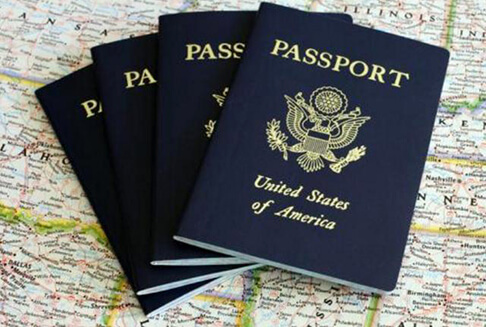
Passport is the First & Foremost Requirement
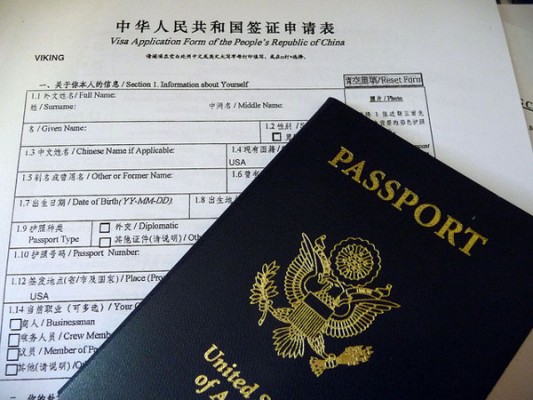
Complete A China Visa Application Form
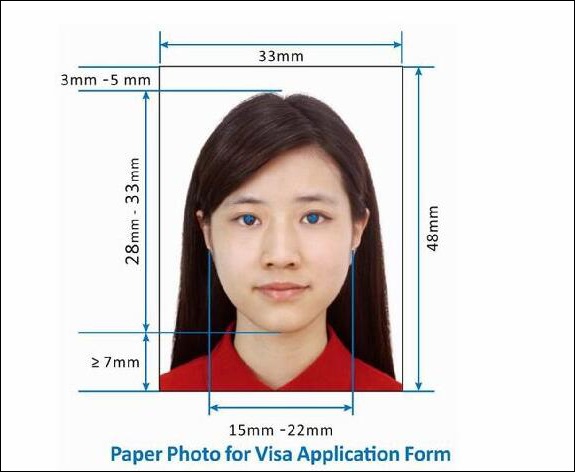
China Visa (Paper) Photo Size Requirement
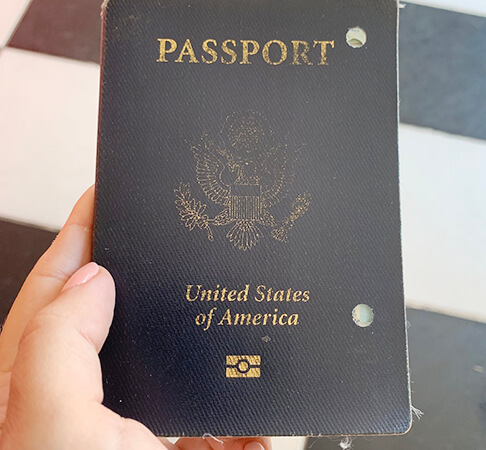
Submit the Old Passport with Former Chinese Visa
Supporting Documents
The supporting document are helpful and necessary proof to the visa officers, that you will go to China in an well-organized, planned way and for good reasons. Thereupon, applicants with different purpose should prepare related materials accordingly.
1. China Tourist Visa - L Visa
2. China Business Visa - M Visa
3. China Work Visa - Z Visa
4. China Student Visa - X1 & X2 Visa
5. China Family Reunion Visa - Q1 & Q2 Visa
6. China Crew Visa - C Visa
7. China Resident Visa - D Visa
8. China Non-commercial Visit Visa - F Visa
9. China Visa-free & Transit Visa - G Visa
10. China Journalist Visa - J1 & J2 Visa
Notes: 1.) What is the visa fee for China? The visa application free differs from visa types, number of entry and nationality. ( How much is a Chinese Visa ) 2.) A holder of category D Visa / J1 Visa / X1 / Q1 / S1 / Z Visa or other types, must apply for a residence permit at the local public security authorities within 30 days of entry into China.
Invitation Letter for China Visa
When applying for most Chinese Visas, a Letter of Invitation (LOI) is required to show the rationality of the upcoming visit. It is a crucial supporting documents applicant should submit with other materials to increase chance of success.
Normally, the invitation letter is issued by a unit (maybe a company, school, and other institutions) or individual who resides in China. The major contents of the letter should include clear and faithful information about the invitee, inviter, and the planed visit. While writing the letter, the inviting party need to check the title and details of the invitation were given accurately and completely.
There is no fixed format and it may be in the form of fax, picture, photocopy, or computer printout. When you submit the Chinese Visa Application, you’re highly recommended to provide the original invitation letter, though most times a photocopy is also accepted.
Here is a template of China Visa Invitation Letter (PDF file) you may refer to.
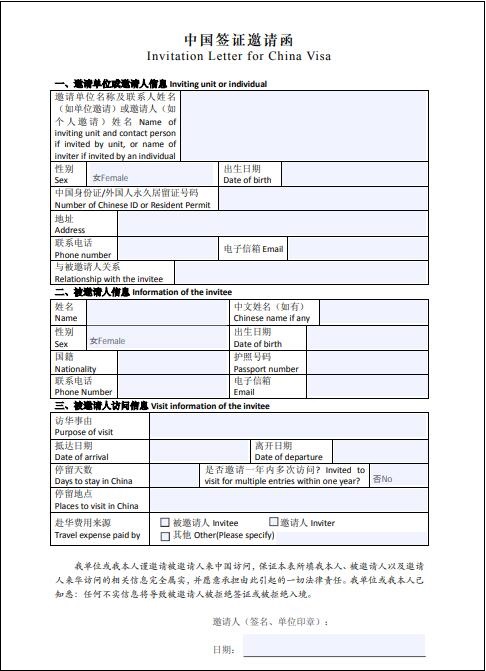
Sample of China Visa Invitation Letter (from China Visa Application Service Center)
Important FAQs and Useful Tips for China Visa Requirements
1. Special notes about visa application form
If your application form is filled by another person or agent, please provide relevant information. A power of attorne y is needed if he/she will submit application and pick up the visa on your behalf.
2. Requirements for long-term Chinese Visa application
Please note that, if you will apply for a long-term multiple entries Chinese Visa, like 10-Year China Tourist/Business Visa, the passport should be valid at least for 1 year . Other requirements remain the same as those short-term visa types.
3. Make copies of every document (except visa form)
The material you prepared to apply for Chinese Visa is very important, probably some are “only one of a kind”. You can download and print out the visa form without limits. However, it would be a very troublesome thing if you lost other original documents. So you’d better make a backup, avoid any contingency.
4. Prepare at least 2 qualified visa photos
Each country and region has different requirements about the number of visa photos, most of them demands 2 photos, few ask 1 only. You're recommended to prepare 2 or more, just in case.
5. Pay Attention to the Invitation Letter
For China Tourist (L) Visa, the letter of invitation is optional, unless you are indeed invited to visit China. For special types of visa, like, J1 Visa, Z Visa, the issuing authorities are specified officially, while normal visas have no explicit restriction.
How to Get a Visa for China - Chinese Visa Application Guide
❶ find out what kind of visa you need.
Read different types of Chinese Visa to figure out which kind of visa you should apply for. Determine if you are suitable applicants for each visa type, by judging your purpose of visiting is for travel, business, work, transit, family reunion and etc or not. China Tourist Visa (L Visa) is for visitor going to China for tourism, F Visa is for exchanges, study tour, Business Visa (M Visa) is for commercial and trade, Student Visa (X Visa) is for studying in China. More Chinese Visa Types >>
❷ Apply for a Chinese Visa
According to various visa policy, applicants meet relevant requirements can submit China Visa application at Chinese Embassy, Diplomatic and Consular Missions or special ports of entry. You need to prepare and submit your valid passport with at least 6 months’ validity and blank pages, copy of passport’s first page, completed visa application form pasted with 2 recent photos (color photo with white background, taken within past 6 months, size: 48mmx33mm), sufficient visa fee and service charge and other supporting documents.
❸ Collect & check your China visa
The processing time differs from visa types. Normally, it takes about 4 to 5 business days for applicant to get a China Visa, and the accurate collection date will be noted on the pick-up slip. If you submit China Tourist Visa (L Visa) on Monday, you can pick up on Thursday. Check carefully the visa type, duration of stay, number of entries if they are issued correctly or not, after getting your passport back. Double check the validity when you plan to enter China, otherwise you will be denied entry. How Long to Get a Chinese Visa >>
Travel China Worry-free with China Discovery
China Discovery is a professional and experienced travel companion who offers high-value and worry-free tours for you. We not only design ideal itinerary covering sightseeing, dining, transfer and hotel, but also can provide Invitation Letter to help you obtain Chinese Visa. If it’s your first time travel to China, Beijing , Shanghai , Xian and Guilin are the top recommended destinations with best representative tourism attractions of. The great cultural, historical, natural landscape will fulfill your dream tour to China. For those who want an in-depth discovery in China, featured China Panda Tour , Ancient Silk Road Tour , High Speed Train Tour , Colorful Ethnic Tour are good ways to find more interesting places and authentic locals.
Most Recommended China Tours:
- ● 6 Days Classic Beijing Xian High Speed Train Tour
- ● 6 Days Beijing Shanghai Tour by High Speed Train
- ● 6 Days Leshan, Mount Emei & Panda Volunteer Tour
- ● 10 Days Classic China Tour from Beijing
- ● 14 Days Shanghai to Yunnan Wild China Expresses Tour
- ● 15 Days Ancient China Silk Road Tour with Bullet Train
If you are interested in China visa-free tour, we could also customize a China Visa-free Tour in Beijing , Shanghai , Xian , Chengdu , Hangzhou and more available destinations if you meet relevant visa requirements.

Top China Visa-Free Cities

Introduction to China Visa
- Ultimate China Visa Guide
- Do I Neee A Visa for China
- How to Read China Visa
- Single, Double, Multiple Entry Visa
- China Tourist Visa
China Visa Application
- How to Apply for China Visa
- China Visa Application Form
- Visa Invitation Letter
- China Visa Application Online
- China Visa Expedited Service
- How Much is A China Visa
- Apply China Visa in HK
- China Visa Renewal & Extension
- Lost Passport & China Visa
China Visa Exemptions
- 15 China Visa Free Policies
- 144-hour Visa Free in China
- 72-hour Visa Free in China
- 53 Visa Free Transit Countries
- Beijing 144-Hour Visa Free
- Shanghai 144-Hour Visa Free
- China Visa Free Countries
- Popualr China Visa Free Tours 2024
- Major Visa Free Cities & Regions
Recommended Tours
Top 3 tours chosen by most customers to explore in the best way. Check the detailed itinerary, or tailor your own trip now with us.

8 Days Best of China Tour (Flight/Bullet Train Covered)
Beijing / Xian / Shanghai

9 Days East China & Mt. Huang Tour by High Speed Train
Shanghai / Suzhou / Hangzhou / Huangshan
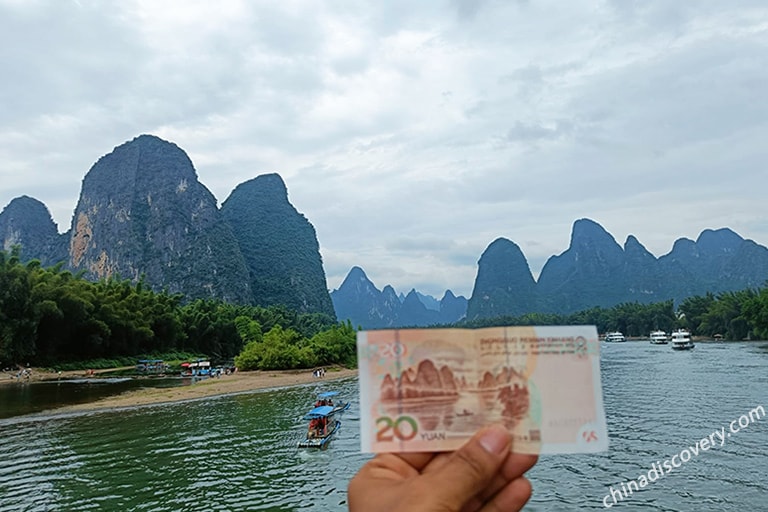
10 Days Classic China Tour from Beijing - First Touch of China
Beijing / Xian / Guilin / Yangshuo / Shanghai
Start planning your tailor-made holiday to China by contacting one of our specialists. Once inquired, you’ll get a response within 0.5~23.5 hours.

Have a question? Get answers from our travel experts or guests
- Your Question:
- Your Email:
- Affordable and valuable price
- 100% tailor-made packages
- Highly rated customers reviews
- Efficient customer support
China Tours
- Top 10 China Tours
- Classic China Tours
- China Tours from Beijing
- China Tours from Shanghai
- China Tours from Hong Kong
- China Tours from Chengdu
- Short China Trips
- Customize China Tour
- China Panda Tours
- Family Tour with Kids
- High-Speed Train Tour
- Silk Road Travel
- Yangtze River Cruise
- Hiking & Trekking Tours
- Photography Tours
- China Minority Travel
- Beijing Shanghai Tours
- Shanghai Yangtze Tours
- Chengdu Jiuzhaigou Tours
- Chengdu Lhasa Tours
- Suzhou Hangzhou Tours
- Guilin & Yangshuo
- Zhangjiajie
“Very good experience”
“WONDERFUL 25 DAYS IN CHINA - PRIVATE TOUR”
“Awesome China tour from northeast to southwest”
Any questions, please email us at: [email protected] or call us at: 86-19138970032 (Monday-Friday 9 a.m. to 6 p.m. GMT+8)
- Terms & Condition
- Privacy Policy
- Customer Support
Copyright © 2011-2024. All rights reserved.
Cookie policy
We use cookies to give you the best experience on our website. Continue using our website means you agree with our cookie policy. For more info, please read here .
- Notice on New Adjustments to Chinese Visa and Entry Policies
- Guide on Epidemic Prevention and Control Measures For China-bound Travelers
- Notice on the Reopening of the Visa Office
- · Visa for Hong Kong SAR and Macao SAR of China(2024-02-29)
- · FAQs About China's Port Visas and Other Related Issues(2024-02-26)
- · Requirements and Procedures for Chinese Visa Application(Updated in February, 2024)(2023-03-14)
- · Tourist Visa (L-Visa) Application Documents to be Simplified(2023-12-29)
- · 2024 Holiday Schedule for the Visa Office of the Chinese Embassy(2023-12-26)
- · Visa Office Close on Dec. 25, 2023 and Jan. 1,2024(2023-12-18)
- · Notice on Reducing Visa Fee(2023-12-08)
- · China to Apply Unilateral Visa -Free Policy to Six More Countries on A Trial Basis(2023-11-25)
- · Notice on Walk-in Without Appointment Visa Application Service(2023-10-20)
- · Chinese Visa Application Frequently Asked Questions(2023-09-18)
- · Compensation Arrangements for the Use-Suspension of 10-year Multi-Entry Visa due to the COVID-19(2023-06-22)
- · Visa Processing Fees(2023-12-08)
- · Notice on New Adjustments to Chinese Visa and Entry Policies(2023-03-13)
- · Notice on the Reopening of the Visa Office(2023-01-12)
- · Hong Kong "e-Visa" Arrangement(2021-12-28)
- · Chinese Visa Photo Requirements(2016-12-05)

China’s Visa Categories Explained
For the intrepid traveler, business mogul, or cultural enthusiast, a trip to China can be an enlightening escapade. But before you can walk the Great Wall, admire the terracotta army, or seal a deal in Shanghai, there’s a significant barrier to cross: obtaining the right visa. China offers a myriad of visa types, each tailored to the diverse needs and reasons that people have for visiting the Middle Kingdom.
Tourist Visa (L Visa)
The L Visa is the go-to for tourists. If your purpose is purely to sightsee, visit family, or explore the vast cultural heritage of China, this is your key to the kingdom. Usually issued for 30 days, it can be extended for an additional 30 days within China. Pack your bags, your itinerary, and proof of hotel bookings; the L Visa is your ticket to the Forbidden City and beyond.
Business Visa (M Visa)
For those venturing into China’s bustling marketplaces and skyscrapers with business on their mind, the M Visa is designed for a short-term commercial stay. This includes attending trade fairs, meeting with clients or partners, or exploring business opportunities. Applicants typically need an invitation from a Chinese business or trade partner, and the duration can vary based on the invitation’s specifics.
Work Visa (Z Visa)
The Z Visa beckons to those who’ve secured employment in China. Whether you’re an engineer, English teacher, or executive, this visa means you’re planning to work and reside in China for an extended period. Along with a host of application documents, a government-issued work permit is crucial for the Z Visa process. Once in China, holders must convert their visa into a residence permit.
Student Visa (X Visa)
Split into X1 and X2 categories, the X Visa caters to students embarking on their academic pursuits. The X1 Visa is for long-term study exceeding six months and necessitates a JW201 or JW202 form issued by the Chinese Ministry of Education. The X2 is for shorter study stints. Both require admission notices from the respective educational institutions in China.
Private Visit Visa (S Visa)
The S Visa is relatively new, designed for those visiting family members residing in China for work or study. The “S” stands for “Private Visit,” and it comes in two flavors: S1 for long-term visits to family members and S2 for shorter visits. Documentation proving family relationships is a must.
Family Reunion Visa (Q Visa)
The Q Visa is similar to the S Visa but is specifically for foreigners with Chinese heritage or those with family ties to Chinese citizens. The Q1 Visa is for long-term stays, while the Q2 is for shorter visits. Evidence of kinship is, naturally, required.
Transit Visa (G Visa)
The G Visa is a transit visa for travelers who are passing through China on their way to another destination. If you’re planning a short layover and want to see a bit of China in the process, this visa allows for a brief glimpse of the country, typically for 24 to 72 hours, depending on your nationality and the point of entry.
Talent Visa (R Visa)
The R Visa is reserved for foreign experts and top talent that China is eager to attract. If you’ve got skills deemed highly necessary or you’re recognized as a high-level talent, this visa offers a pathway to China. The R Visa often requires proof of expertise and recognition in your field.
Journalist Visa (J Visa)
The J Visa comes in two types: J1 for long-term and J2 for short-term journalistic assignments. Applicants usually need to be officially accredited journalists and are required to coordinate with the Chinese authorities for their reporting activities within the country.
Permanent Residence Visa (D Visa)
The D Visa is the golden ticket for those seeking to make China their new long-term home. It’s as close as it gets to a ‘green card’ in China and is reserved for those who have either made significant contributions to the Chinese society or who are moving for family reunification.
In the labyrinth of Chinese visas, each path is carefully constructed to meet the legal and regulatory requirements of different visitors. Understanding which visa to apply for is crucial, as it determines not just the success of your application but the ease of your journey. As with the ancient Silk Road, navigating China’s visa requirements is about preparation, understanding, and often, a bit of patience.
Before you embark on your journey, check the latest updates from the nearest Chinese embassy or consulate, as regulations can change. And remember, while the paperwork might seem daunting, the experiences awaiting you in China are worth every stamped document and filled form.
Here are several official websites where you can find up-to-date information on visa policies for China:
- This is the official visa application service established by the Chinese Embassy and Consulates to streamline the visa application process.
- For U.S. citizens or residents, this is the direct source for visa guidelines, application procedures, and announcements.
- The ministry provides diplomatic insights and has a section for consular services, including visa affairs.
- This is the official platform for immigration policies, including visa regulations in China.
- While not a Chinese government entity, IATA provides travel and visa restrictions information that is frequently updated and can be a useful reference.
- Offers detailed information on Chinese consular services, including visa applications for foreigners.
- Specifically focused on services for foreigners visiting China, including visa information.
Remember that visa regulations can change, and there may be additional requirements or restrictions due to international developments, such as public health concerns. Always check for the most recent updates before making travel plans or submitting a visa application.
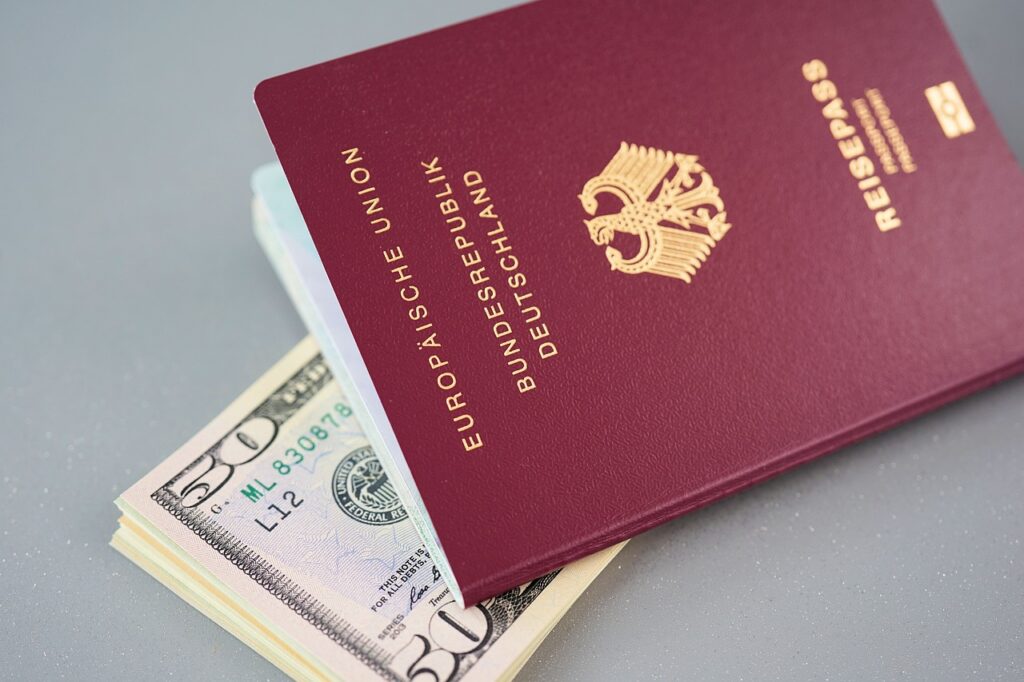
Leave a Comment Cancel Reply
Your email address will not be published. Required fields are marked *
Save my name, email, and website in this browser for the next time I comment.
1. Basic Concepts
(1) A visa is a travel document issued by authorized government agencies to foreign citizens applying to enter, transit through or exit from the host country's territory based on the host country's laws and regulations. In accordance with international law and practice, any sovereign state is entitled to determine whether to allow a foreign citizen to enter or exit from its territory, and whether to issue a visa, decline a visa application or to cancel an issued visa in accordance with its national laws.
(2) Chinese embassies, consulates and other institutions stationed abroad authorized by the Ministry of Foreign Affairs of China are visa-issuing authorities responsible for issuance of visas to foreign citizens abroad, and are entitled to determine the type, number of entries, validity and duration of each stay of a visa to be issued, or to decline a visa application or revoke an issued visa, in accordance with Chinese laws and regulations. According to Chinese law, a foreign citizen may be refused to enter China even if he/she has a valid Chinese visa.
(3) Foreign citizens must obtain a visa before entering China, with the exception of visa-free entry based on relevant agreements or regulations (Please refer to the website of the Chinese Consular Services or National Immigration Administration https://en.nia.gov.cn/ ). Foreign citizens that fall into categories of Article 22 of the Exit and Entry Law of the People's Republic of China are qualified to apply for port visas from visa-issuing authorities entrusted by the Ministry of Public Security at a port of entry approved to issue port visas by the State Council.
(4) For visits to Hong Kong Special Administrative Region (HKSAR) or Macao Special Administrative Region (Macao SAR), an entry visa must be obtained as required by the Government of HKSAR or Macao SAR, except citizens from some countries or regions exempted from visas for short term visit. Visa applications must be made separately if the traveler wishes to visit both HKSAR/Macao SAR and China's mainland.
2. Visa types
There are four types of Chinese visas: Diplomatic visa, Courtesy visa, Service visa and Ordinary visa.
Ordinary visas are further divided into the following categories. Please apply for the visa which most suits your specific circumstances.
3. Visa validity
Visa validity("Enter before") means that the visa is valid,or can be used for entering China from the date of issue to the "Enter before" date indicated on the visa (Beijing Time). If a visa has unused entries, the bearer can enter China before 24:00 (Beijing Time) on the expiration date. A visa becomes invalid if all the entries are used up or if the visa has expired even though there are entries unused.
"Entries" refers to the number of times the visa bearer is permitted to enter China during the validity of a visa. A visa becomes invalid if there are no entries left, or if there are entries left but the visa expires.
5. Duration of each stay
"Duration of each stay" refers to the maximum days the visa bearer is permitted to stay in China on each visit, which is calculated from the next day of your entry into China.
6. Important notice
(1) The Consulate-General of China in Sydney does not directly accept the visa applications from ordinary passport holders. For visas to China's mainland, HKSAR or Macao SAR, the applications should be submitted to the Chinese Visa Application Service Center in Sydney.
The address and contact details of the Chinese Visa Application Service Center in Sydney are as follows:
Address: Level 1, 140 William Street,Woolloomooloo, NSW 2011, Sydney
Website: https://www.visaforchina.cn/SYD2_EN/
Telephone: 02-94758800
Fax: 02-94758899
Email: [email protected]
(2) Diplomatic or Official (Service) passport holders need to submit their applications to the Consulate-General of China in Sydney directly. The applicants for R visa (including spouses and minor children of R visa applicants) could submit their applications to the Chinese Visa Application Service Center in Sydney ( https://www.visaforchina.cn/SYD2_EN/ ), or to the Consulate-General of China in Sydney directly.
(3) For more information, please visit the China Consular Service Network ( http://cs.mfa.gov.cn/wgrlh/lhqz/lhqzjjs/ ) or the Chinese Visa Application Service Center in Sydney ( https://www.visaforchina.cn/SYD2_EN/ ).
- You pick the destination, we have all the visa information ready

- What are the China Private Visit Visa (S Visas) Requirements?
- Chinese visa
- China visitor visa: Application Process, Requirements, Application Fee
China is located in East Asia and is the second-largest country in the world in terms of land area. For this reason, it has the longest borderline among all countries in the world. In fact, China has a border with 14 different countries. That is why many tourists travel to China by land. In addition to its size, China is also one of the top economies. In fact, China has the second strongest economy in the world. China is a favorite destination for foreign students around the world; in this regard, the Chinese government offers 2 kinds of visas for their parents and relatives to come to China: China private visit visa S1 and S2.
For this reason, apart from tourists, many businessmen and merchants travel to China every year. Of course, people in most countries of the world are required to obtain a Chinese visa to enter China. So, if your sister, brother, child, parent, or spouse is living in China and wants to visit him or her, you must apply for a China private visit visa – more familiar to foreigners as an S visa or sometimes as a dependent visa.
Table of Contents
How to obtain China private visa?
As we said, the condition for entering China to visit a relative is to obtain a china private visit visa. To obtain such a visa, you must follow the rules. Fortunately, for China private visit visa, you do not require to be present at the embassy in order to obtain a visa, as the Chinese embassy does not interview applicants. Therefore, you can entrust it to experts in this field to rely on their experience and knowledge to obtain the visa for you as soon as possible.

Whether you do it yourself or leave it to your lawyer, In any case, before going to the embassy, you must fill out two copies of the visa application form. Then submit the forms and other necessary documents to the Chinese Consular Office. After confirmation, the documents and forms must be submitted to the China Embassy.
Of course, sometimes, even though all the documents are valid and there are no problems, the embassy prevents the issuance of a China private visit visa. Under these circumstances, the type of visa you are applying for may conflict with your purpose of traveling to China. Therefore, you should be careful in choosing the type of visa. In addition, it is necessary to know the types of visas.
China Private Visit Visa (S) visa or dependent visa
Since China is the center of the world economy, after the United States, many businessmen and capitalists migrated to this country. China is also a popular destination for international students, with millions of students entering the country each year to continue their education.
Therefore, the parents of these people and their relatives are very eager to meet their loved ones in China. On the other hand, the China government has provided a specific visa for relatives of those who are doing business in this country or are students of a Chinese university. This visa is called China private visit visa – or S visa.
What is China Private Visit Visa S1?
This type of China visa is issued for travel to China and living with a first-class family. First-degree families include spouses, parents, children under the age of 18, and mother-in-law and father-in-law.
This visa is a one-time entry, and its duration is more than 180 days. Proof of kinship is one of the requirements of this visa. Holders of S1 visas (China private visit visas) must apply for a residence permit from the China Public Security Administration (Police Station) within 30 days of arrival in China. Having a residence permit, a person will be allowed to enter and leave the country legally.
Want to move to China as a doctor? Read our article.
What is China Private Visit Visa S2?
The S2 China Private Visit Visa is a short-term S1 visa issued to foreigners visiting their family members working in China. The length of stay allowed on this type of visa is between 30-90 days per visit. Proof of kinship is required to meet with family members. S2 visas are usually multiple-entry, and their validity for US passport holders is 10 years.
With this chart below, all the application conditions are explained:
What are the China Private Visit Visa (S Visas) Requirements & Documents?
Invitation from the inviter (a foreign national who resides in China for work or study), which includes:
Specific documents for China Private Visit Visa S1
- Information about the applicant (name, gender, date of birth, etc.)
- Travel information (purpose of the trip, date of arrival and departure, place of residence, the relationship between the applicant and the invitee, source of funding for expenses, etc.)
- Inviter information (name, contact number, address, signature, etc.)
- Photocopy of passport and residence permit of the inviting person
- Original and copy of the certificate (marriage certificate, birth certificate, kinship certificate issued by the Public Security Office, or notarized certificate of kinship) which shows the relationship between the applicant and the invitee.
“First-degree family members” are referred to as the couple, parents, children under 18, and parents-in-law.
Note: S1 visa holders must submit their application to the General Directorate of Exit / Entry of Public Security Institutions under the supervision of the Local Government at the provincial level in the proposed places for the residence of foreign nationals within 30 days from the date of arrival.
Read our article and learn about immigration ways to China as a software engineer.
Specific documents for China Private Visit Visa S2
The following documents are required to visit family members for a short period:
- Copy of certificates (marriage certificate, birth certificate, certificate of kinship, or notarized certificate of kinship) which shows the relationship between the family members of the applicant and the inviter.
Note: In private affairs, documents identifying the nature of private affairs must be provided to the consular officer.
Let’s Sum Up…
This article is recommended for those who have a first-degree family in China and are looking to visit them. You have seen that China’s private visit visa is divided into two categories, S1 and S2, each of which has its own characteristics. On the Visa Library website, you can learn about other US visas (like tourist visas , F visas, group visas , and transit visas ) as well as ways to immigrate to other countries.
If you already have this visa, be sure to leave us a comment. Your feedback will be very useful for our readers. You can also get updated information on all European, American, Asian, and Oceanic visas on the visa library website.
How useful was this article?
Click on a star to rate it!
Average rating 5 / 5. Vote count: 2
No votes so far! Be the first to rate this article.
Before you can apply to become a teacher in British Columbia, Canada, or anywhere else in the country, you need…
Yes, it is indeed feasible to convert your current visa status in South Korea from student (D2) to dependent family…
Yes, you can practice dentistry or teach at dental schools in Malaysia after earning your Bachelor of Dental Surgery degree…
China Visa Types
China visa consists of 16 major types, which are respectively marked with Chinese phonetic letters L, M, F, Z, X1, X2, S1, S2, Q1, Q2, C, J-1, J-2, G, D, and R. Diplomatic visa and service visa must be obtained through government channel, which is not covered on this page.

Tourist Visa (L)

Business Visa (M)

Non-Commerce Visa (F)

Work Visa (Z)

Study Visa (X1/X2)

Private Visa (S1, Long Term)

Private Visa (S2, Short Term)

Family Visa (Q1, Long Term)

Family Visa (Q2, Short Term)

Crew Visa (C)

Transit Visa (G)
*To apply for the emergency humanitarian visa for the purpose of arranging funeral matters or visiting a family member in critical medical conditions in China, applicants shall submit the identity document of the deceased or critically ill patient (such as a Chinese identity card or a foreign passport), a death certificate or a medical certificate of the patient issued by the hospital, proof of kinship, and other necessary documents as required.
III. Application Procedures:
To apply for the above visas, applicants are required to fill in the online application form and make an appointment on the Chinese Visa Application Service Centre (CVASC) website before submitting applications in person on the date of the appointment and having their ten fingers ’ fingerprints collected. Children under the age of 14 and adults above the age of 70 are not required to go to the CVASC for such biometric information collection. Please contact the CVASC for specific procedures, visa application requirements, processing time and fees.
IV. Diplomatic, service or courtesy visa applicants shall also submit applications at the CVASC. The applicants are not required to pre-book time slots, but shall complete and print out the online application forms in advance.
V. Foreign nationals who apply for visas for the Hong Kong Special Administrative Region or the Macao Special Administrative Region can submit applications to the consular section of the Chinese Embassy/Consulates in the UK during business hours with no need for pre-booked appointments.
VI. Visa applications for visiting purposes which are not included above will not be accepted at the moment.
VII. Holder of a valid Chinese residence permit, or valid permanent documents and APEC Business Travel Cards ( excluding Virtual ABTC) does not need to apply for a new visa for entry into China .

STRONGLY RECOMMENDED FOR ALL APPLICANTS!Complete and detaile...
Most frequently used functions like online application form,...

- About the Visa Centre
- Office Hours & Location
- Legal Information
- Help by E-MAIL
- Suggestions and Complaints
- 2023/10/17 Dussehra Holiday Notice
- 2023/09/18 Holiday Notice for 9.29-10.6
- 2023/09/01 Notice for temporary closure on 2023.9.08.
- 2023/08/18 Notice on Temporary Exemption of Collection of Biometric Data
- 2023/08/11 Notice for 15th Aug 2023
- 2023/08/04 Notice for online appointment.


How To Apply For China's Tourist Visa: Easy Step-By-Step Guide
I had never been as frustrated with travel planning as when I was applying for my 10-year tourist visa to China this year.
I didn’t blame the fact that China required a visa, I blamed the confusing process of how to apply. The lack of a step-by-step guide for people in the USA mixed with the confusing lawyer-like language used in the China Embassy’s official documents = pure confusion on what to do.
After scouring the web to piece together the full process, I finally set out to apply for the 10-year tourist visa. In less than a week of applying online , I picked up my visa and was good to travel for the next 10 years!
Looking back on it, I’m glad I got it over with early on in my travel planning process. I would’ve hated to have to deal with all of this 1-2 weeks before my trip!
For reference, I applied for the 10-year tourist visa in April, but my trip wasn’t until November.
Once you figure out HOW to apply and actually submit your application, it’s really not too bad. Especially since I’ve created this easy-to-understand guide to walk you through all the steps you need to apply for your very own China tourist visa.
NOTE: This guide is for US citizens applying for the tourist visa (L) within the USA. I don’t have experience with any other countries/nationalities, thanks!
Before Applying For The China Tourist Visa: Things You Need To Know
- The first and most important thing I need to mention: there is no way of applying for a China visa completely online . You will need to physically provide your passport to a visa office at some point. There’s no way around this, and that’s because they need to stick your new China visa onto one of the pages in your passport.
- You must start by completing a visa application form to apply for a China visa. This can be done online or on paper.
- You’ll then need to submit your visa application form + supporting documents to a China Visa Application Service Center (this is a physical place). These are going to be at a Chinese embassy or consulate somewhere in the USA. There are multiple locations.
- You can’t just choose any location you feel like. You have to go to the one that services your state/area. More on this later.
- a recently-taken color photo behind a white wall (can be uploaded digitally if filling out the application online, or a physical photo if applying on paper application)
- a valid passport
- printed out visa application + confirmation letter
- other supporting documents (more on this later)
- You’ll need to visit the visa office twice: first to submit your application, then again in 3-4 days to pick up your passport (with your brand new China visa inside).
- You can apply in person for yourself, have someone else turn in the forms for you / pick up your visa for you, or pay a travel agency to do it all for you.
- That’s the general overview of the process. Let’s dive into the details a bit more.
Step 1: Find a consulate location that services your area.
The first thing you’ll want to do is locate which Consulate General location you’ll have to go to in order to apply for (and pick up) your visa. You can use this link to see all the current locations.
You CANNOT pick one randomly, you can only go to the one that services your area.
So how do you know which consulate you have to go to? Locate where you live on this list or this list . Your state/region will be listed under one of the consulates. That’s the one you’ll need to go to.
For example, I live in Northern California, so I had to go to the Consulate General in San Francisco . If you live in Utah, your assigned location is the Embassy in Washington DC.
Also, note that the area formerly serviced by the Houston consulate is temporarily being serviced by the Embassy in the United States (DC location) as the one in Houston closed down.
Step 2: Fill out the COVA application
Start your online application . Go to the China Online Visa Application (COVA) and fill out the application using your information.
You’ll be asked all kinds of questions: personal information, the type of visa you’re applying for, how long you want it for, names of family members (parents), work history, emergency contact info, where you’re going to be traveling to in China and on what dates, where you’ve traveled to in the last 12 months, etc.
I would allot 30 minutes of your time to fill out the whole application. It felt like forever when I was applying, but I think it took me about 30 minutes. You can always save your progress if you need to look up information and revisit the application process at a later time.
Just be sure to note your application ID so you can pull it up later.
I’ll give you some pointers on how I filled out my application because some questions were quite confusing.
- One of the first things you need to do is upload your passport photo. I took a selfie against a wall and used Lightroom to turn my gray background white. The system accepted the photo. (Background must be white!)
- For Given name(s), it should include your first name followed by any middle name(s). It needs to match the name on the passport.
- For National ID number, I applied with N/A
- For Type of Visa, I selected (L) Tourism. Here are the rest of the visa types for reference.
- For Visa Duration, I entered 120 months with a maximum stay of 60 days. I also chose “multiple” for the number of entries.
- For Itinerary information, I ballparked my travel dates from city to city (Hong Kong – Xi’An – Chengdu – Chongqing) as I had not yet booked my flights, but I gave the best estimate I could based on where we were in the trip planning process.
- Since they are no longer requiring flight confirmations and hotel confirmations, the trip itinerary section doesn’t need to be very detailed. Addresses of hotels didn’t seem to even be required fields (I filled out half of them for the ones we had already booked).
- For Work Experience info, I did the best I could but it’s okay not to be exact. For example, I included my previous employer’s general phone number instead of my supervisor’s number. You can also provide a quick description of your job duties (my example: “blogger/travel writer”). No need to go into detail.
Normally visa applications take 3-4 days to process, but you can specify in this application to expedite it (2-3 days).
I chose not to expedite my application. I applied on a Monday and received a pick-up date of Thursday .
How quickly do you need the visa?
- If you live in the area and can get to the visa office pretty easily, no need to expedite.
- If you’re traveling from out-of-state to apply, you’ll probably want to expedite to save on an extra night’s worth of hotel costs.
- If your trip’s departure is like next week, you’ll probably want to expedite to be on the safe side!
Should you apply for a 3-month visa or a 10-year visa? The visa process is the same regardless if you apply for 3 months or 10 years. Moreover, it’s currently the same price!
My entire family and I went for the 10-year option as we knew we’d be visiting China a lot once my parents retired!
Step 3: Print out/gather all your documents.
Once you finish filling out the application, you’ll get a confirmation letter that looks like it’s got QR codes on it. You’ll have to print this out along with a few other things to bring to the visa office.
Here’s the full list that was required of me when I was applying (April 2024). Be sure to check for the latest requirements !!!
- Confirmation letter – you need to print and sign this
- Completed visa application – you need to print and sign this (on the last page)
- Your physical passport
- Photocopy of your passport’s bio page (the page that shows the photo and the document number)
- Proof of residence documentation (a photocopy of your ID, bank statement, utility bill, etc.)
- I did single-sided printing and printed pages in color just in case.
- When you print the visa application, make sure to include the confirmation page as the first page.
- I did not bring a physical copy of my photo since I had uploaded it along with my online application. This was not asked for at the visa center either.
Step 4: Show up at the visa center.
At the time of writing, you can’t make appointments online. They are taking walk-ins only.
When you are looking for the address of where to go, look for the consulate’s Visa Application Office , not the general Embassy address.
For example, I GPS’ed to the Consulate General of the People’s Republic of China in San Francisco . Once I got to the door (on Laguna St.), I saw a sign letting visa application visitors know that the Visa Application Office was on the street perpendicular to where I was (Geary Blvd.).
Depending on the time you visit, be prepared to wait.
I showed up at 9:15am on a Monday (15 minutes before they opened) and there were at least 70 people in line in front of me. Despite the crazy-sounding line, it didn’t take as long as I had anticipated! I was out of there by 10:55am.
PRO TIP: For the SF location, show up near closing time as opposed to first thing in the morning. I asked the security guard when the best time to visit was for the shortest lines, and he told me “at the end of the day, right before we close”.
This may vary by location, so take that tip with a grain of salt! But when I went to pick up my visa 3 days later, I showed up at 1:50pm (the visa office closed at 2:30pm) — and he was right — no lines! There must have been 10 people in the entire office compared to my initial visit where there were 100+ people waiting at the same time.
Once you’re there, hand all of your documents to the visa processer. He/she will look your application over (rather quickly) and make sure you have all the necessary docs. They will then take all of your documents (including your passport) for processing/approval.
If all looks good, you’ll get a slip of paper (pick-up slip) telling you exactly what date to come back to pick up your passport. You can come anytime on that date. Again, no appointment is needed.
My experience: For proof of residence, I had actually just brought my physical driver’s license instead of making a photocopy of it. The lady told me I had to go to make a photocopy of it, then go back to her window once I was done with that.
Luckily, the office had a set of photocopiers (costs $0.25 per page) as well as passport photobooths (for people who forget to bring photos for their applications). Bring quarters or some dollar bills in case you need to use the copy machine.
Step 5: Pick up your passport.
After a few days, it’s time to go back to pick up your passport. When you go to pick up your passport, you will pay for the visa at this time.
There’s a separate line that moves much faster for passport pick-ups. For my pick-up, I was in and out of the visa office in under 10 minutes.
Since a lot of people applying for China visas are from out of state, they often worry about how long it takes to pick up their passports.
Again, in general, your passport will be ready in 2-4 days, depending on if you choose expedited service.
Also, you don’t even need to be the one showing up at the visa office! Per the Los Angeles consulate site , “visa applications may be submitted in person by the applicant or someone else with the passport and all supporting documents”.
Once you flip through your passport booklet, you’ll find a brand-new visa glued to one of your passport pages. Viola ! You are ready to go to China!
Lastly, stay updated with the latest info!
The latest info/updates will always be on the China Visa Applications website . I know, it’s hard to read because of how outdated and simple the site looks, but there’s always useful info on there.
Like when I was applying, I was able to see that they had recently reduced the visa fee to $140, regardless of how long the visa’s duration is. And that at the end of 2023, they had actually simplified the visa application to not require flight confirmations, proof of hotel reservation, or invitation letters.
Meanwhile, all the other outdated websites and blog posts out there mentioned needing an invitation letter.
To be clear, as of April 2024 (when I wrote this), invitation letters are NOT required.
Always refer to the China Visa Applications website for the latest info!
Hope this step-by-step guide to applying for the China tourist visa was helpful. You can message me if you have any additional questions about applying for a tourist visa as a US citizen.
Other Posts You’ll Love:
Where to stay in osaka, japan: neighborhood guide, 23 top things to do in shinjuku, tokyo’s high-energy district, 21 fun and exciting things to do in tokyo at night, 10 best budget hotels in tokyo (near jr yamanote line), 10 other cities worth visiting near tokyo, japan, 15 best hotels in tokyo near jr yamanote line (with map).

Update April 12, 2024
Information for u.s. citizens in the middle east.
- Travel Advisories |
- Contact Us |
- MyTravelGov |
Find U.S. Embassies & Consulates
Travel.state.gov, congressional liaison, special issuance agency, u.s. passports, international travel, intercountry adoption, international parental child abduction, records and authentications, popular links, travel advisories, mytravelgov, stay connected, legal resources, legal information, info for u.s. law enforcement, replace or certify documents, tourism & visit.
Study & Exchange
Other Visa Categories
U.S. Visa: Reciprocity and Civil Documents by Country
Share this page:
Visitor Visa
Visa Waiver Program
Travel Without a Visa
Citizens of Canada and Bermuda
Generally, a citizen of a foreign country who wishes to enter the United States must first obtain a visa, either a nonimmigrant visa for a temporary stay, or an immigrant visa for permanent residence. Visitor visas are nonimmigrant visas for persons who want to enter the United States temporarily for business (visa category B-1), for tourism (visa category B-2), or for a combination of both purposes (B-1/B-2).
Here are some examples of activities permitted with a visitor visa:
Business (B-1)
- Consult with business associates
- Attend a scientific, educational, professional, or business convention or conference
- Settle an estate
- Negotiate a contract
Tourism (B-2)
- Vacation (holiday)
- Visit with friends or relatives
- Medical treatment
- Participation in social events hosted by fraternal, social, or service organizations
- Participation by amateurs in musical, sports, or similar events or contests, if not being paid for participating
- Enrollment in a short recreational course of study, not for credit toward a degree (for example, a two-day cooking class while on vacation)
Travel Purposes Not Permitted On Visitor Visas
These are some examples of activities that require different categories of visas and cannot be done while on a visitor visa:
- Paid performances, or any professional performance before a paying audience
- Arrival as a crewmember on a ship or aircraft
- Work as foreign press, in radio, film, print journalism, or other information media
- Permanent residence in the United States
Visitor visas will also not be issued for birth tourism (travel for the primary purpose of giving birth in the United States to obtain U.S. citizenship for their child).
How to Apply
There are several steps to apply for a visa. The order of these steps and how you complete them may vary by U.S. Embassy or Consulate. Please consult the instructions on the U.S. Embassy or Consulate website .
Complete the Online Visa Application
- Online Nonimmigrant Visa Application, Form DS-160 – Learn more about completing the DS-160 . You must: 1) complete the online visa application and 2) print the application form confirmation page to bring to your interview.
- Photo – You will upload your photo while completing the online Form DS-160. Your photo must be in the format explained in the Photograph Requirements .
Schedule an Interview
Interviews are generally required for visa applicants with certain limited exceptions below. Consular officers may require an interview of any visa applicant.
You should schedule an appointment for your visa interview at the U.S. Embassy or Consulate in the country where you live. You may schedule your interview at another U.S. Embassy or Consulate, but be aware that it may be more difficult to qualify for a visa outside of the country where you live.
Wait times for interview appointments vary by location, season, and visa category, so you should apply for your visa early. Review the interview wait time for the location where you will apply:
Appointment Wait Time
Check the estimated wait time for a nonimmigrant visa interview appointment at a U.S. Embassy or Consulate.
Note: Please check the individual Embassy or Consulate website to determine if your case is eligible for a waiver of the in-person interview.
Applicants scheduling visa appointments in a location different from their place of residence should check post websites for nonresident wait times.
Select a U.S. Embassy or Consulate:
Prepare for your interview.
- Fees - Pay the non-refundable visa application fee , if you are required to pay it before your interview. If your visa is approved, you may also need to pay a visa issuance fee, if applicable to your nationality. Fee information is provided below:
Select your nationality to see Issuance Fee
- Review the instructions available on the website of the U.S. Embassy or Consulate where you will apply to learn more about fee payment.
Gather Required Documentation
Gather and prepare the following required documents before your visa interview:
- Passport valid for travel to the United States – Your passport must be valid for at least six months beyond your period of stay in the United States (unless exempt by country-specific agreements ). Each individual who needs a visa must submit a separate application, including any family members listed in your passport.
- Nonimmigrant Visa Application, Form DS-160 confirmation page.
- Application fee payment receipt, if you are required to pay before your interview.
- Photo – You will upload your photo while completing the online Form DS-160. If the photo upload fails, you must bring one printed photo in the format explained in the Photograph Requirements .
Additional Documentation May Be Required
Review the instructions for how to apply for a visa on the website of the U.S. Embassy or Consulate where you will apply. Additional documents may be requested to establish if you are qualified. For example, additional requested documents may include evidence of:
- The purpose of your trip,
- Your intent to depart the United States after your trip, and/or
- Your ability to pay all costs of the trip.
Evidence of your employment and/or your family ties may be sufficient to show the purpose of your trip and your intent to return to your home country. If you cannot cover all the costs for your trip, you may show evidence that another person will cover some or all costs for your trip.
Note: Visa applicants must qualify on the basis of the applicant's residence and ties abroad, rather than assurances from U.S. family and friends. A letter of invitation or Affidavit of Support is not needed to apply for a visitor visa. If you choose to bring a letter of invitation or Affidavit of Support to your interview, please remember it is not one of the factors used in determining whether to issue or deny the visa.
Attend Your Visa Interview
A consular officer will interview you to determine whether you are qualified to receive a visitor visa. You must establish that you meet the requirements under U.S. law to receive a visa. Ink-free, digital fingerprint scans are taken as part of the application process. They are usually taken during your interview, but this varies based on location.
After your visa interview, the consular officer may determine that your application requires further administrative processing . The consular officer will inform you if this required.
After the visa is approved, you may need to pay a visa issuance fee (if applicable to your nationality), and make arrangements for the return of the passport and visa to you. Review the visa processing times to learn more.
Entering the United States
A visa allows a foreign citizen to travel to a U.S. port-of-entry (generally an airport) and request permission to enter the United States. A visa does not guarantee entry into the United States. The Department of Homeland Security (DHS), U.S. Customs and Border Protection (CBP) officials at the port-of-entry have authority to permit or deny admission to the United States. If you are allowed to enter the United States, the CBP official will provide an admission stamp or a paper Form I-94, Arrival/Departure Record. Learn more about admissions and entry requirements, restrictions about bringing food, agricultural products, and other restricted/prohibited goods, and more by reviewing the CBP website .
Extending Your Stay
See Extend Your Stay on the U.S. Citizenship and Immigration Services (USCIS) website to learn about requesting to extend your stay beyond the date indicated on your admission stamp or paper Form I-94.
Failure to depart the United States on time will result in being out of status . Under U.S. law, visas of individuals who are out of status are automatically voided ( Section 222(g) of the Immigration and Nationality Act ). Any multiple entry visa that was voided due to being out of status will not be valid for future entries into the United States.
Failure to depart the United States on time may also result in you being ineligible for visas in the future. Review Visa Denials and Ineligibilities and Waivers: Laws to learn more.
Change of Status
If your plans change while in the United States (for example, you marry a U.S. citizen or receive an offer of employment), you may be able to request a change in your nonimmigrant status to another category through U.S. Citizenship and Immigration Services (USCIS). See Change My Nonimmigrant Status on the USCIS website to learn more.
While you are in the United States, receiving a change of status from USCIS does not require you to apply for a new visa. However, once you depart the United States you must apply for a new visa at a U.S. Embassy or Consulate in the appropriate category for your travel.
Additional Information
- An individual on a visitor visa (B1/B2) is not permitted to accept employment or work in the United States.
- There is no guarantee you will be issued a visa. Do not make final travel plans or buy tickets until you have a visa.
- A valid U.S. visa in an expired passport is still valid. Unless canceled or revoked, a visa is valid until its expiration date. If you have a valid visa in your expired passport, do not remove it from your expired passport. You may use your valid visa in your expired passport along with a new valid passport for travel and admission to the United States.
Travel for Medical Treatment
If you are seeking medical treatment in the United States, the consular officer may ask for further documents at your visa interview, which may include:
- Medical diagnosis from a local physician, explaining the nature of the ailment and the reason you need treatment in the United States.
- Letter from a physician or medical facility in the United States, stating they are willing to treat your specific ailment and detailing the projected length and cost of treatment (including doctors’ fees, hospitalization fees, and all medical-related expenses).
- Proof that your transportation, medical, and living expenses in the United States will be paid. This may be in the form of bank or other statements of income/savings or certified copies of income tax returns (either yours or the person or organization paying for your treatment).
Visitor Visas for Personal or Domestic Employees (B-1)
You may apply for a B-1 visitor visa to work in the United States as a personal or domestic employee for your employer in limited situations. You may work in the United States on a visitor visa if your employer is:
- A U.S. citizen who has a permanent home or is stationed in a foreign country, but is visiting or is assigned to the United States temporarily; or
- A foreign citizen who is in the United States on one of the following nonimmigrant visa categories: B, E, F, H, I, J, L, M, O, P, or Q.
Learn more about your rights in the United States and protection available to you by reading the Legal Rights and Protections pamphlet.
Visa Renewal
Whether you are applying for the first time or renewing your visa, you will use the same application process (please review How to Apply , above). Some applicants seeking to renew their visas in certain visa classes may be eligible for the Interview Waiver (IW) which allows qualified individuals to apply for visa renewals without being interviewed in person by a U.S. consular officer. Review the instructions on the website of the U.S. Embassy or Consulate where you will apply to determine if the IW is available and if you qualify.
Do I need a visa if I have an ABTC?
Yes, you will still need a visa to travel to the United States, unless you qualify for the Visa Waiver Program . Having an Asian-Pacific Economic Cooperation (APEC) Business Travelers Card (ABTC) does not change visa requirements, your visa status, or the visa process for travel to the United States.
How can I use my ABTC when I apply for my visa?
If you have an Asian-Pacific Economic Cooperation (APEC) Business Travelers Card (ABTC), you might be able to schedule an expedited visa interview appointment. Review the instructions for scheduling expedited appointments on the website of the embassy or consulate where you will apply.
Visa Annotations for Certain Maritime Industry Workers
Certain foreign maritime workers are eligible to apply for a Transportation Worker Identification Credential (TWIC) once in the U.S. If you, as a maritime industry worker, will perform services in secure port areas, your visa must be annotated “TWIC Letter Received.” Workers whose visas are not annotated will not be permitted by the Transportation Security Administration (TSA) to apply for a TWIC.
In order for your visa to be annotated, you must obtain a letter from your employer explaining the need for a TWIC and that you are a potential TWIC applicant. See a template example of this letter. You must present this letter when you apply for the B-1 visa. You must meet all other eligibility requirements for a B-1 visa.
Complete information about the TWIC program is available on TSA’s website at https://www.tsa.gov/for-industry/twic .
Visa Denial and Ineligibility
Review Visa Denials for detailed information about visa ineligibilities, denials and waivers.
I was refused a visa, under Section 214(b). May I reapply?
Yes, if you feel circumstances have changed regarding your application. Review Visa Denials to learn more.
Misrepresentation or Fraud
Attempting to obtain a visa by the willful misrepresentation of a material fact, or fraud, may result in the permanent refusal of a visa or denial of entry into the United States.
Review Ineligibilities and Waivers: Laws .
Citizens of Canada and Bermuda do not require visas to enter the United States, for visit, tourism and temporary business travel purposes. For more information see U.S. Embassy Ottawa website , U.S. Consulate Hamilton website and CBP website .
Additional resources for Canadian visitors to the United States can be found on the U.S. Embassy and Consulate websites in Canada.
Citizens of China
In accordance with the agreement signed between the United States and China to extend visa validity, beginning on November 29, 2016, Chinese citizens with 10-year B1, B2 or B1/B2 visas in Peoples’ Republic of China passports will be required to update their biographical and other information from their visa application via a website every two years, or upon getting a new passport or B1, B2, or B1/B2 visa, whichever occurs first. This mechanism is called EVUS - Electronic Visa Update System.
The EVUS website is now open to the public for enrollments at www.EVUS.gov . CBP will not collect a fee for EVUS enrollment at this time. CBP anticipates the eventual implementation of an EVUS enrollment fee, but does not have a time frame. Until the implementation of a fee, travelers can enroll in EVUS without charge. The Department of Homeland Security, Customs and Border Protection (CBP) will keep visa holders informed of new information throughout the year. For further information, please visit www.cbp.gov/EVUS .
根据美中双方签署的延长签证有效期的协议,自2016年11月29日起,凡持有10 年 期B1,B2 或 B1/B2签证的中华人民共和国护照持有人需要每两年或在获取新护照或最长有效期的B1、B2或B1/B2签证时时(以先到者为准),通过网站更新他们签证申请上的个人资料及其它信息。这个机制我们称之为EVUS –签证更新电子系统。
EVUS的登记网站 www.EVUS.gov 现已开放接受登记。美国海关和边境保护局(CBP)目前不会收取登记费用。美国海关和边境保护局预期EVUS登记收费最终会实施,但目前尚未落实执行时间。在收费实施前,旅客可以免费完成EVUS登记。美国国土安全部海关和边境保护局将在今年及时向签证持有人公布最新的信息。获取更多的信息,请访问 www.cbp.gov/EVUS 。
Citizens of Mexico
Citizens and permanent residents of Mexico generally must have a nonimmigrant visa or Border Crossing Card (also known as a "Laser Visa"). For ease of travel, the B-1/B-2 and the Border Crossing Card have been combined into one document (DSP-150). Select Border Crossing Card to learn more about this card.
Please visit U.S. Embassy or Consulate websites for more information regarding applying for a visa at the U.S. Embassy or Consulates in Mexico.
Further Questions
- Case-Specific Questions - Contact the U.S. Embassy or Consulate handling your visa application for status information. Select U.S. Embassy or Consulate for contact information.
- General Questions - review Contact Us .
Visa Waiver Program (VWP)
Tourist or business travelers who are citizens of participating countries may be eligible to visit the United States without a visa. Visits must be 90 days or less, and travelers must meet all requirements.
Citizens of Canada and Bermuda generally do not need visas for tourism and visits.
More Information
A-Z Index Legal Rights & Protections Lost/Stolen Travel Documents Denials Fraud Warning Visa Expiration Date Automatic Revalidation Nonimmigrants in the United States–Applying for Visas in Canada or Mexico Visa Applicants - State Sponsors of Terrorism Border Security/Safety Find a U.S. Embassy or Consulate Customer Service Statement
External Link
You are about to leave travel.state.gov for an external website that is not maintained by the U.S. Department of State.
Links to external websites are provided as a convenience and should not be construed as an endorsement by the U.S. Department of State of the views or products contained therein. If you wish to remain on travel.state.gov, click the "cancel" message.
You are about to visit:
- Ambassador's Message
- CV of Ambassador
- Ambassadors of China to Pakistan
- Economy & Trade
- China-Pakistan Economic Corridor (CPEC)
- Culture & Arts
- Science & Tech
- Notice/Reminder
- Visa Application
- Notarization & Attestation
- Security Reminder
- Contact Information
- About China
- Important Notice
More From Forbes
More than 1 million indians waiting for highly skilled immigrant visas.
- Share to Facebook
- Share to Twitter
- Share to Linkedin
People are reflected in the window of the Nasdaq MarketSite in Times Square in New York City. U.S. ... [+] government data has confirmed that more than one million Indians now wait in employment-based immigration backlogs, highlighting problems in the U.S. immigration system. Many work for technology companies in the United States. (Photo by Spencer Platt/Getty Images)
U.S. government data confirm that more than one million Indians now wait in employment-based immigration backlogs, highlighting problems in the U.S. immigration system. The data from U.S. Citizenship and Immigration Services indicate many highly skilled professionals from India face potentially decades-long waits to gain permanent residence (a green card) due to a per-country limit and the low annual quota. The waits create personal turmoil for individuals and families, affecting America’s ability to attract and retain talent .
Analysis Of USCIS Data
Over 1.2 million Indians, including dependents, are waiting in the first, second and third employment-based green card categories, according to a National Foundation for American Policy analysis of USCIS data . The data reflect approved I-140 immigrant petitions as of November 2, 2023.
NFAP analyzed the data and calculated the dependents to arrive at an estimated backlog in the top three employment-based immigration categories (excluding “other workers”).
First Preference: According to USCIS, 51,249 principals are in the employment-based first preference, also known as EB-1. NFAP estimates an additional 92,248 dependents for a total of 143,497 Indians in the first preference backlog. EB-1 includes workers with extraordinary ability, outstanding professors and researchers and multinational executives or managers.
Second Preference: According to USCIS, as of November 2, 2023, there were 419,392 principals in the employment-based second preference, also known as EB-2. NFAP estimates an additional 419,392 dependents for a total of 838,784 Indians in the second preference backlog. EB-2 includes professionals holding an advanced degree and persons with exceptional ability in the sciences, arts or business.
Best High-Yield Savings Accounts Of 2024
Best 5% interest savings accounts of 2024.
USCIS data from 2020 suggest that the Indian backlog in the EB-2 category rose by more than 240,000 or 40% in approximately three years.
Third Preference: According to USCIS, 138,581 principals are in the employment-based third preference, also known as EB-3. NFAP estimates an additional 138,581 dependents for a total of 277,162 Indians in the third preference backlog. EB-3 includes skilled workers and “members of the professions whose jobs require at least a baccalaureate degree.” (Unskilled or “Other Workers” in the third preference are not included in the analysis.)
According to the National Foundation for American Policy’s analysis of USCIS data, there are 1,259,443 Indians in the top three employment-based immigration categories as of November 2, 2023.
USCIS says the agency’s data does not “identify or exclude multiple petitions by the same petitioner or beneficiary.” However, NFAP based its estimates of dependents on the ratio of employment visa principals to dependents in FY 2021 and FY 2022 for all countries of origin. That would underestimate dependents for Indians because their long waits in the backlog mean they would be older than other employment-based immigrants and more likely to have spouses and multiple children.
Without Congressional action, the backlog will continue to increase. In 2020, the Congressional Research Service (CRS) estimated the backlog for Indians in the top three employment-based green card categories would reach 2,195,795 individuals by FY 2030 and take 195 years to eliminate the backlog.
The Visa Bulletin And Chinese Immigrants
The per-country limit (discussed below) also affects would-be employment-based immigrants from China and the Philippines. NFAP estimates that nearly 148,000 Chinese professionals and their dependents are waiting in the employment-based green card backlog, with approximately 83,000 in the second preference and 41,000 in the third preference.
According to the May 2024 Visa Bulletin , Indians can receive their green card in the employment-based second preference only if their application was filed before May 15, 2012. While that provides a general sense of an applicant’s wait time, for Indians, the dates in the Visa Bulletin often do not advance monthly and sometimes may regress. For Chinese, the date in the May 2024 Visa Bulletin is June 1, 2020. For comparison, for the rest of the world, the application filing date to be eligible to receive a green card in the second preference is last year—February 15, 2023. (See here for background on interpreting the Visa Bulletin.)
“Applicants for immigrant visas who have a priority date earlier than the application date in the [Visa Bulletin] chart may assemble and submit required documents to the Department of State’s National Visa Center,” according to the State Department .
The Reasons For The Long Green Card Wait Times
Two parts of U.S. law created the long wait times for employment-based immigrants. In 1990, Congress set the annual limit for employment-based green cards at 140,000, including dependents, a level far from high enough since the demand for technical talent has exploded in recent decades due to the internet, smartphones, AI, e-commerce and other innovations. At the same time, lawmakers retained a per-country limit of 7%. The per-country limit has most harmed highly skilled professionals from India, China and the Philippines due to larger populations.
Indians have suffered the brunt of the law’s impact. Due to the per-country limit, only 7,820 Indian immigrants received employment-based green cards in the EB-2 category in FY 2015, even though employers submitted tens of thousands of green card applications for Indians years earlier than individuals from other countries who received green cards that year.
In 2022, Senator Charles Grassley (R-IA), supported by Senate Republican Leader Mitch McConnell, blocked a reform that would have ended the long waits for many employment-based immigrants. Analysts say Grassley’s blocking of the exemption for highly educated immigrants caused potentially irreparable harm to America’s ability to attract and retain foreign-born scientists and engineers in the United States.
When the House of Representatives passed the America COMPETES (CHIPS) Act, it included an exemption from annual green card limits and backlogs for foreign nationals with a Ph.D. in STEM fields and those with a master’s degree “in a critical industry.” During the House-Senate conference committee on the bill, the Biden administration, Rep. Zoe Lofgren (D-CA), businesses and universities argued for keeping the provisions. However, Grassley, the ranking Republican on the Senate Judiciary Committee, blocked the immigration measures from becoming law.
The Impact Of Long Green Card Wait Times
In July 2023, a Forbes article reported on Canada’s program to entice H-1B visa holders. The number of applications was so overwhelming that the 10,000 limit was reached in less than 48 hours. “The response is likely a warning sign to U.S. policymakers that many highly sought foreign-born scientists and engineers in the United States are dissatisfied with the U.S. immigration system and seeking other options.”
Beyond the hit to U.S. competitiveness and companies’ ability to retain talent in the United States, the long waits for employment-based green cards exact a human toll.
Emily Neumann, a managing partner at Reddy Neumann Brown PC, noted a recent application for a client who has needed to renew his H-1B five times while waiting for his green card priority date. “He’s been with the company for 16 years. Still no green card solely because he was born in India.” An H-1B denial, layoff or economic downturn could force him to leave the country.
Roshan Taroll’s story illustrates the impact of the employment-based green card problem. It shows the immigration system creates fear and uncertainty that sways the course of people’s lives, including the children of highly skilled immigrants.
Roshan was born in India and came to America as a 10-year-old with his parents in 2008. His mother worked in H-1B status for a U.S. technology company, which sponsored her for an employment-based green card in 2010. Eight years later, in 2018, Roshan’s mother died before she was granted her green card. The low annual employment-based immigrant visa limit and the per-country limit affecting Indians caused the long wait and prevented her from becoming a permanent resident.
Family members can use the employment-based visa petition of a deceased principal to gain permanent residence. However, Roshan turned 21 and “aged out” of being included on his mother’s application before the “priority date” arrived. (See this interview and the website of Improve The Dream , which focuses on “child dependents of long-term visa holders.”)
Even though Roshan grew up in Boston, he needed to obtain F-1 international student status to attend Boston College. After graduating, he has worked for a company on Optional Practical Training for three years.
Roshan has experience in a high-demand field—semiconductor manufacturing—but due to the low annual limit on H-1B petitions, his company could not secure an H-1B visa for him despite attempts in three separate H-1B lotteries. (According to analysts, the yearly limit of 85,000 new H-1B petitions for companies is reached annually because it is inadequate for a technology-based economy with a labor force of more than 160 million people.)
As a result, even though he has lived in America since he was 10 years old, Roshan will soon have to leave the United States. He appreciates the company’s efforts to find a location where he can use his education and training to work for the corporation in another country.
“It's been challenging,” said Roshan. “With my mother's passing, she moved us to this country to give us a better life and ensure that we were educated and did well. Now that I have to leave, I won’t be able to fulfill her wishes of living my life in the United States.”

- Editorial Standards
- Reprints & Permissions
We've detected unusual activity from your computer network
To continue, please click the box below to let us know you're not a robot.
Why did this happen?
Please make sure your browser supports JavaScript and cookies and that you are not blocking them from loading. For more information you can review our Terms of Service and Cookie Policy .
For inquiries related to this message please contact our support team and provide the reference ID below.

Blinken will be the latest top US official to visit China in a bid to keep ties on an even keel
The Associated Press
April 20, 2024, 2:21 PM
- Share This:
- share on facebook
- share on threads
- share on linkedin
- share on email
WASHINGTON (AP) — Secretary of State Antony Blinken will travel to China this coming week as Washington and Beijing try to keep ties on an even keel despite major differences on issues from the path to peace in the Middle East to the supply of synthetic opioids that have heightened fears over global stability.
The rivals are at odds on numerous fronts, including Russia’s war in Ukraine, Taiwan and the South China Sea , North Korea, Hong Kong, human rights and the detention of American citizens. The United States and China also are battling over trade and commerce issues, with President Joe Biden announcing new tariffs on imports of Chinese steel this past week.
The State Department said Saturday that Blinken, on his second visit to China in less than a year , will travel to Shanghai and Beijing starting Wednesday for three days of meetings with senior Chinese officials, including Foreign Minister Wang Yi. Talks between Blinken and Chinese President Xi Jinping are expected, although neither side will confirm such a meeting is happening until shortly before it takes place.
The department said in a statement that Blinken would “discuss a range of bilateral, regional, and global issues,” including the Middle East, the war in Ukraine, the South China Sea and the Taiwan Strait.
He will also talk about progress made in “resuming counternarcotics cooperation, military-to-military communication, artificial intelligence, and strengthening people-to-people ties” and will reaffirm how important it is for the U.S. and China to be “responsibly managing competition, even in areas where our two countries disagree,” State Department spokesman Matthew Miller said.
The trip follows a phone call this month between Biden and Xi in which they pledged to keep high-level contacts open, something they had agreed to last year at a face-to-face summit in California. Since that call, Treasury Secretary Janet Yellen has visited China and Defense Secretary Lloyd Austin has spoken by phone with his Chinese counterpart . Meetings at lower levels also have taken place.
Despite those encounters, relations are rocky. The U.S. has recently become more vocal in its calls for China to stop supporting Russia’s military-industrial sector, which Washington says has allowed Moscow to boost weapons production to support the war against Ukraine .
“We see China sharing machine tools, semiconductors, other dual-use items that have helped Russia rebuild the defense industrial base that sanctions and export controls had done so much to degrade,” Blinken said Friday. “Now, if China purports on the one hand to want good relations with Europe and other countries, it can’t on the other hand be fueling what is the biggest threat to European security since the end of the Cold War.”
Blinken also has pushed for China to take a more active stance in pressing Iran not to escalate tensions in the Middle East . He has spoken to his Chinese counterpart several times since the Israel-Hamas war began six months ago as he has sought China’s help in getting Iran to restrain proxy groups it has supported, armed and funded in the region.
That topic has taken on new urgency since direct back-and-forth attacks by Iran and Israel on each other’s soil in the past week.
Also high on the agenda for Blinken will be Taiwan and the South China Sea.
The U.S. has strongly condemned Chinese military exercises threatening Taiwan, which Beijing regards as a renegade province and vowed to reunify with the mainland by force if necessary. Successive U.S. administrations have steadily ramped up military support and sales for Taipei, much to the anger of Chinese officials.
In the South China Sea, the U.S. and others have become increasingly concerned by provocative Chinese actions in and around disputed areas. In particular, the U.S. has voiced objections to what it says are Chinese attempts to thwart legitimate activities by others in the waterway, notably the Philippines and Vietnam.
That was a major topic of concern earlier this month when Biden held a three-way summit with the prime minister of Japan and the president of the Philippines.
Copyright © 2024 The Associated Press. All rights reserved. This material may not be published, broadcast, written or redistributed.
Related News

The House passes billions in aid for Ukraine and Israel after months of struggle. Next is the Senate

Biden avoids a further Mideast spiral as Israel and Iran show restraint. But for how long?

After Congress finally does pass new funding, this is how the US can rush weapons to Ukraine
Recommended.

Prince George's Co. executive wants to 'get these guns off the streets' following Greenbelt shooting of 5 teens

Third temporary channel opens for vessels to Baltimore port after bridge collapse

5 teens shot, injured at 'senior skip day' gathering in Greenbelt park
Related categories:.

IMAGES
VIDEO
COMMENTS
China Tourist Visa, or called China Travel Visa, is issued to those who intend to go to mainland China for sightseeing and touring.. Individual tourists can apply for single-entry (3-month validity), double-entry (3 to 6-month validity) or multiple-entry (valid for 6 months, or 1 year) Tourist Visa based on own needs. And, there are also single-entry Tourist Group Visa with validity of no more ...
Starting from January 1, 2024, the Chinese Embassy and Consulates-General in the United States simplify application documents required for tourist visa (L-visa). Tourist visa applicants within the United States will no longer be required to submit round-trip air ticket booking record, proof of hotel reservation, itinerary or invitation letter.
The L Visa, also known as the Tourist Visa, is one of the most commonly applied for categories of China visas. This visa is intended for individuals who wish to visit China for tourism purposes such as sightseeing, visiting friends and family, or engaging in other non-business related activities. The L Visa is typically issued for a period of ...
For individuals transiting through China. 5. J Visa—Journalist Visa. Available in long-term (J1) and short-term (J2) categories for foreign journalists. 6. L Visa—Tourist Visa. For tourists visiting China. If not eligible for China's visa-free entry policy, travelers need to apply for an L visa at the Chinese embassy or consulate abroad ...
Select a destination. Check requirements. 2. Find out which visa you need. There are many types of China visa. Choose a visa type that applies to your situation. If you are planning to go on a vacation in China, apply for a Tourist Visa (L Visa). 3. Prepare the required documents.
Chinese visas fall into two categories: ordinary and diplomatic visas. The ordinary visa consists of several types, which are respectively marked as L, F, M, Z, X1, X2, C, J1, J2. ... The Q2 Visa is issued to family members of Chinese citizens or permanent residents of China who intend to visit China temporarily. The Q2 Visa can be multiple ...
China Tourist Visa Requirements & Documents. 1. Passport. - Your passport with at least 6 months remaining validity and available blank pages, and a photocopy of passport's data page. 2. Application Form. - One accurately completed China Visa Application Form. Please fill in every column of the application form.
According to Chinese laws and regulations, all applicants must submit materials meeting relevant requirements, otherwise, your visa application will NOT be accepted and processed. Once confirm that you need a visa to visit China, and know which visa category (Main Types of Chinese Visa) you should apply for, you shall prepare all required documents before submitting your Chinese Visa application.
Home > Consular Services > Applications > Visa Application. · Visa for Hong Kong SAR and Macao SAR of China(2024-02-29). · FAQs About China's Port Visas and Other Related Issues(2024-02-26). · Requirements and Procedures for Chinese Visa Application (Updated in February, 2024)(2023-03-14).
Split into X1 and X2 categories, the X Visa caters to students embarking on their academic pursuits. The X1 Visa is for long-term study exceeding six months and necessitates a JW201 or JW202 form issued by the Chinese Ministry of Education. ... Both require admission notices from the respective educational institutions in China. Private Visit ...
Introduction to Chinese visa. 2021/03/10. 1. Basic Concepts. (1) A visa is a travel document issued by authorized government agencies to foreign citizens applying to enter, transit through or exit from the host country's territory based on the host country's laws and regulations. In accordance with international law and practice, any sovereign ...
What are Chinese visas?. Chinese visa, is an authorization granted by the People's Republic of China's visa authority to a foreign national for entry into, exit from, or transit through Chinese territory in line with its laws and regulations. In accordance with the status, intended use, and type of passport of the foreign national, the ...
Residence visa for child to be fostered in China. 5. Relative of Chinese citizen (s) living in China applying for a visa for visit less than 180 days. Q2. 05Clik to see the details. Relative of foreigner (s) with permanent residence status in China applying for a visa for visit less than 180 days. 6.
Here are the documents you shall prepare before submission of visa application: I. Basic Documents. (1) Passport. Original passport with at least six months of remaining validity and blank visa pages, and a photocopy of the passport's data page and the photo page if it is separate. (2) Visa Application Form and Photo.
Proof of kinship is one of the requirements of this visa. Holders of S1 visas (China private visit visas) must apply for a residence permit from the China Public Security Administration (Police Station) within 30 days of arrival in China. Having a residence permit, a person will be allowed to enter and leave the country legally.
China Visa Types. China visa consists of 16 major types, which are respectively marked with Chinese phonetic letters L, M, F, Z, X1, X2, S1, S2, Q1, Q2, C, J-1, J-2, G, D, and R. Diplomatic visa and service visa must be obtained through government channel, which is not covered on this page.
Starting from 0 8 January 2023, the Chinese Embassy and Consulates in the UK will adjust the scope of visa applications to visit China as follows: . I. Basic Documents 1. Passport. Original passport with at least six months of remaining validity , blank visa pages, and a photocopy of the bio data page.. 2. Visa Application Form and Photo. One completed Visa Application Form with a recently ...
Visa Authentication; About Us. About the Visa Centre; Office Hours & Location; Legal Information; Help by E-MAIL; Suggestions and Complaints; 2023/10/17 Dussehra Holiday Notice 2023/09/18 Holiday Notice for 9.29-10.6 2023/09/01 Notice for temporary closure on 2023.9.08. ...
The first thing you'll want to do is locate which Consulate General location you'll have to go to in order to apply for (and pick up) your visa. You can use. this link. to see all the current ...
*What the abbreviations above mean - Before applying for a visa at a U.S. embassy or consulate, the following is required:. DOL = The U.S. employer must obtain foreign labor certification from the U.S. Department of Labor, prior to filing a petition with USCIS.; USCIS = U.S. Citizenship and Immigration Services (USCIS) approval of a petition or application (The required petition or application ...
Generally, a citizen of a foreign country who wishes to enter the United States must first obtain a visa, either a nonimmigrant visa for a temporary stay, or an immigrant visa for permanent residence. Visitor visas are nonimmigrant visas for persons who want to enter the United States temporarily for business (visa category B-1), for tourism (visa category B-2), or for a combination of both ...
The online visa application and online appointment for visa application submission (2018-06-28) Visa for Hong Kong SAR of China (2019-01-15) New Information on F & M Visas (2018-03-29) Photo Requirement for Chinese Visa Application (2016-11-25)
Chinese visas fall into 4types: diplomatic visa, courtesy visa, service visa and ordinary visa. Ordinary visas are further divided into 12 sub-types or 16 categories. Photography Dateofvisaissuance =thedatesincethe visaisvalidandcan beused Dateofvisaexpiration =thedateuntilwhen thevisaisvalidandcan beused Numberofentries: 01-oneentry 02-twoentries
Meanwhile, the NIA issued nearly 466,000 visas for foreigners in the first quarter of this year, up 118.8 per cent year on year. The total number of trips by all travellers more than doubled ...
China's coming May Day holiday already has the makings of a major tourism rush, with early bookings exceeding pre-pandemic levels and the travel boom likely to fuel a much-desired round of ...
For Chinese, the date in the May 2024 Visa Bulletin is June 1, 2020. For comparison, for the rest of the world, the application filing date to be eligible to receive a green card in the second ...
Getting into Germany as an Indian tourist requires a little more effort. As a tourist, you will most likely want to apply for a short-term Schengen area visa, known also as a C visa. It grants the ...
German Chancellor Olaf Scholz is in China for a three-day diplomatic visit that includes meetings with Chinese leader Xi Jinping.. Accompanied by a high-level business delegation, the German ...
India also cut the import duty on EVs last month and said to get tax concessions, foreign companies will have to invest at least 41.5 billion rupees ($500 million) and start producing EVs from a ...
WASHINGTON (AP) — Secretary of State Antony Blinken will travel to China this coming week as Washington and Beijing try to keep ties on an even keel despite major differences on issues from the ...